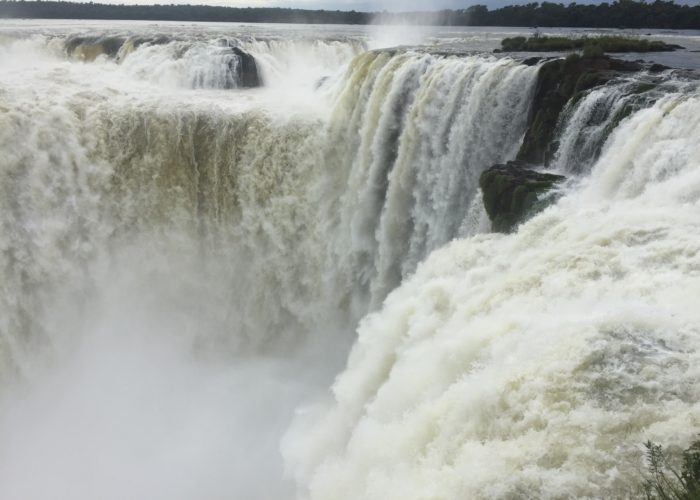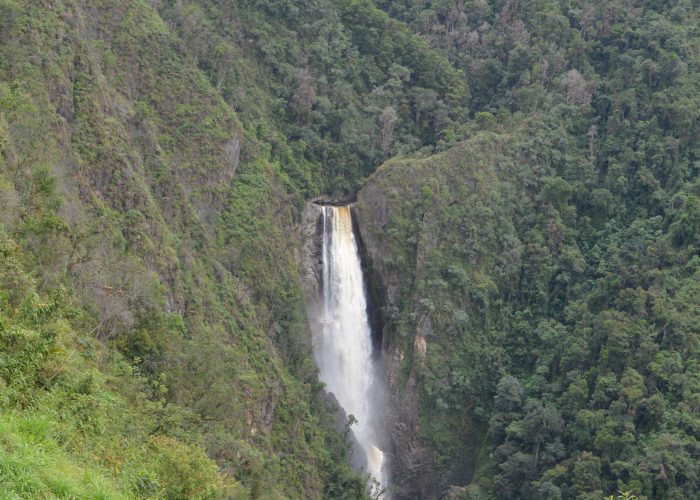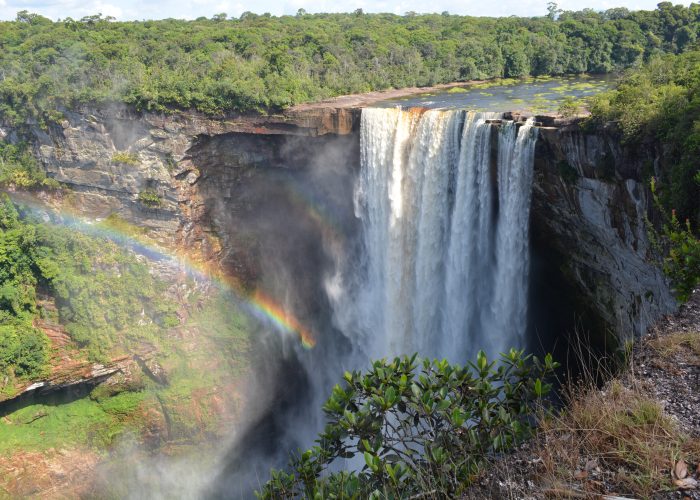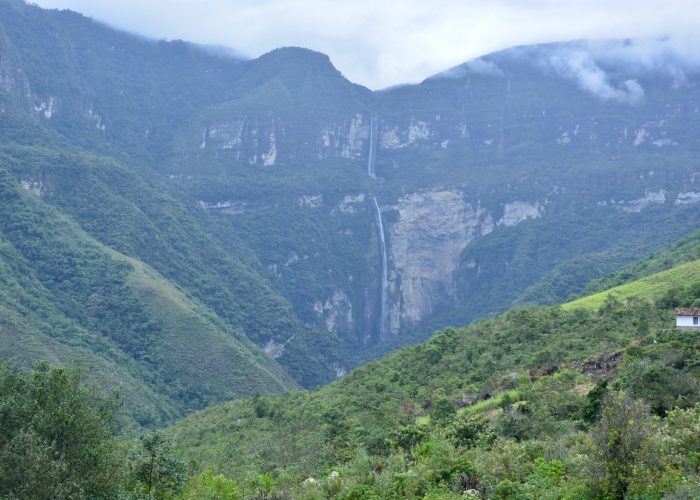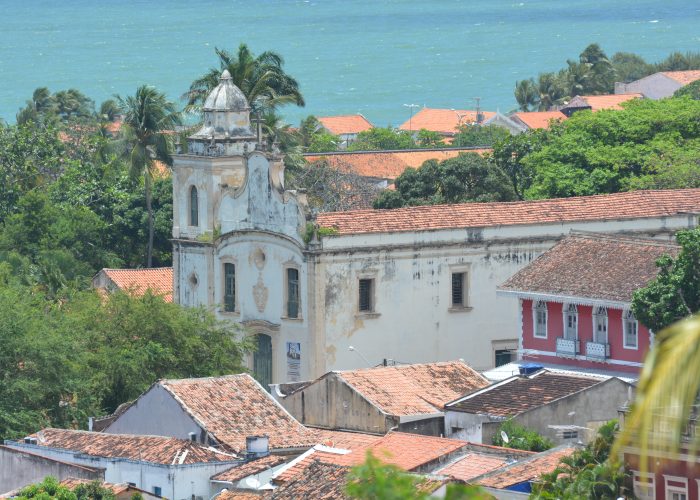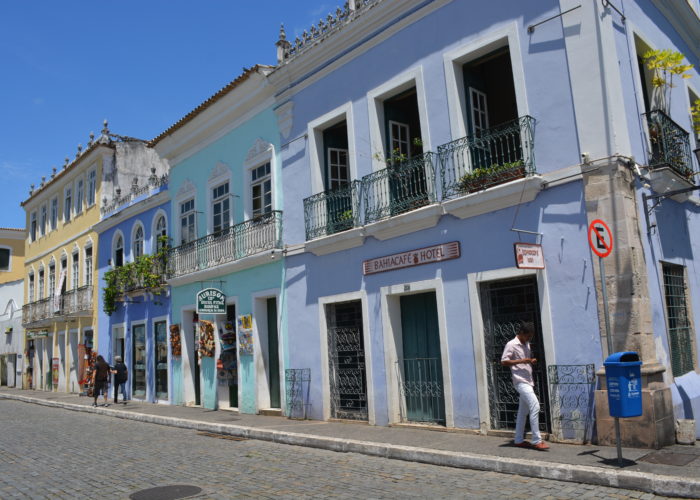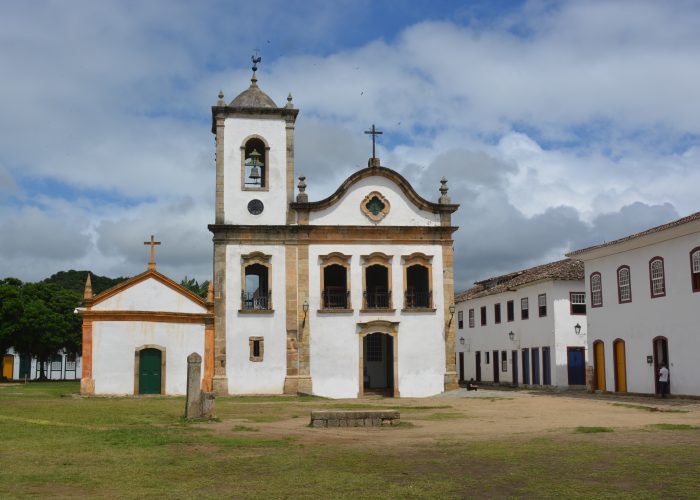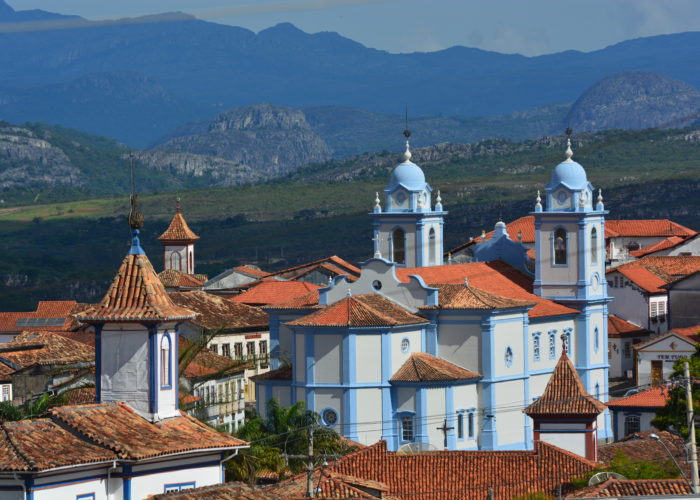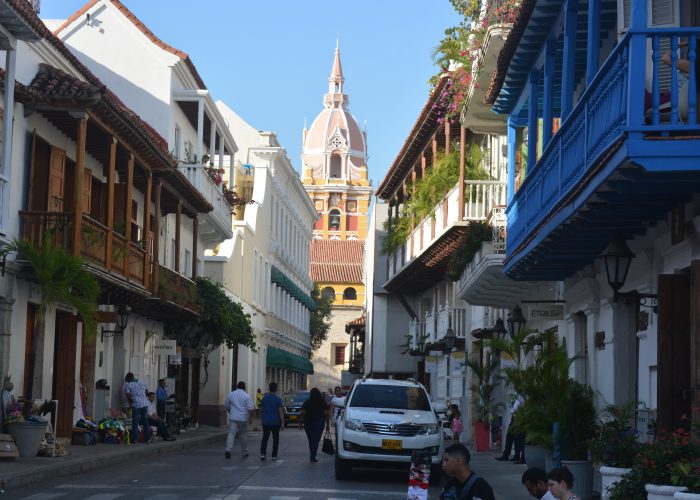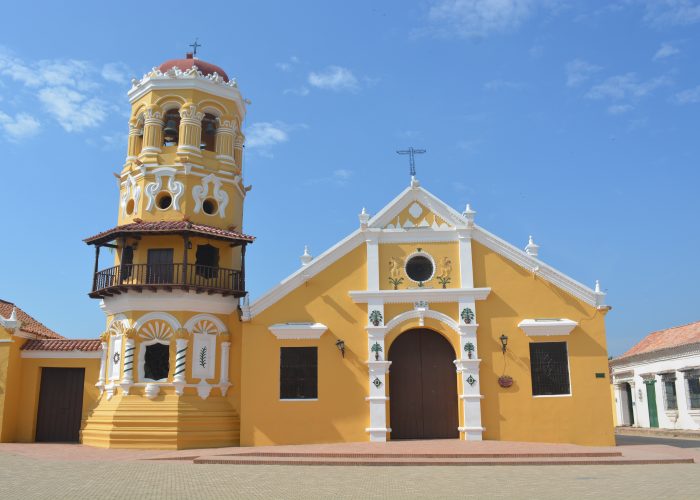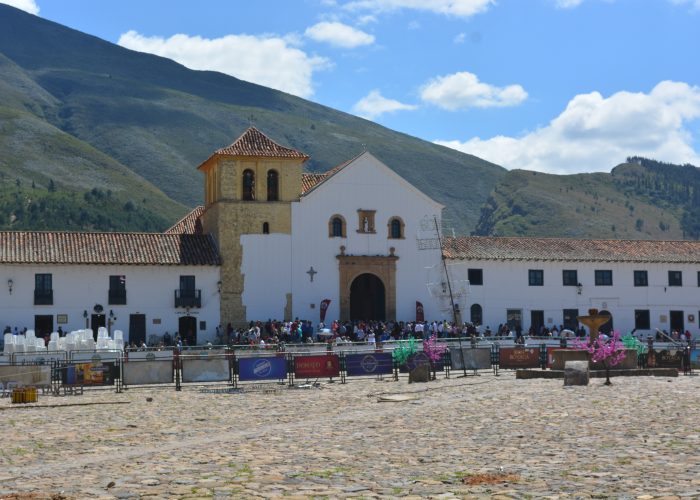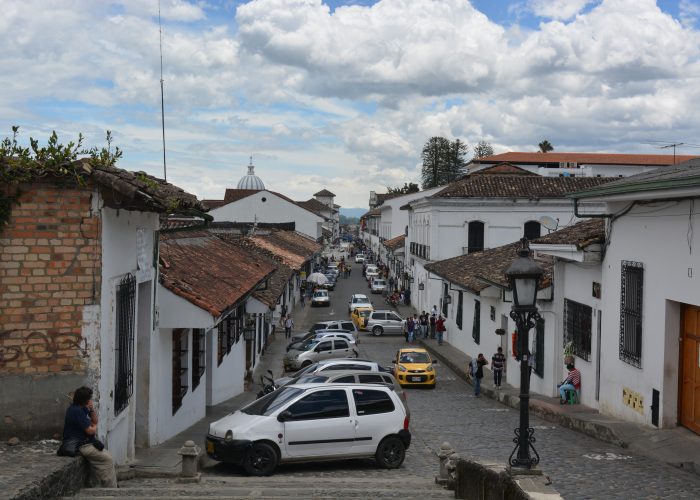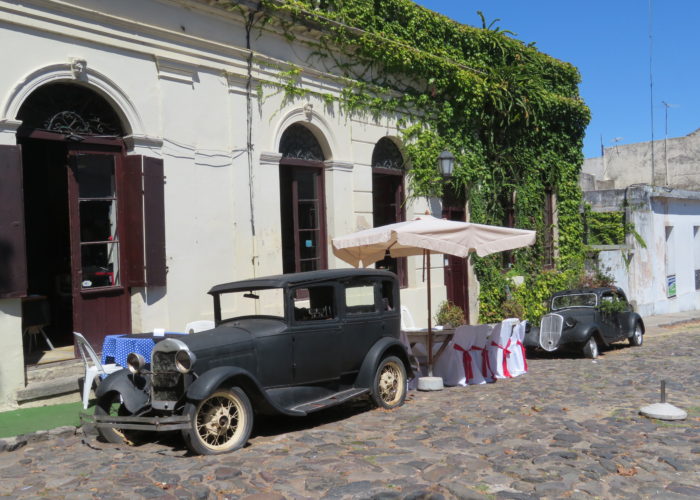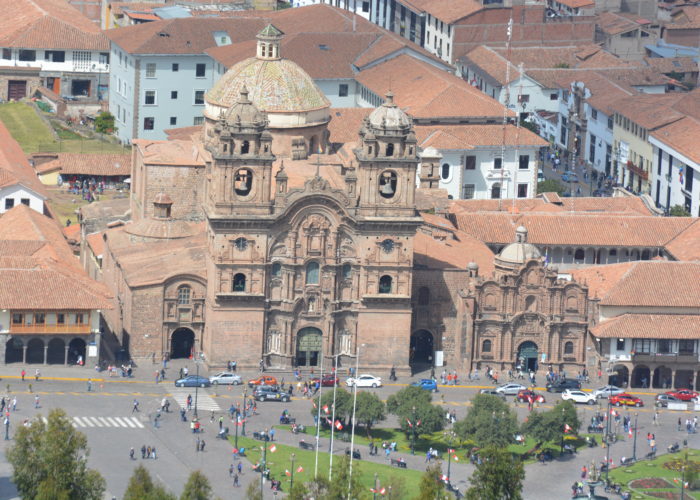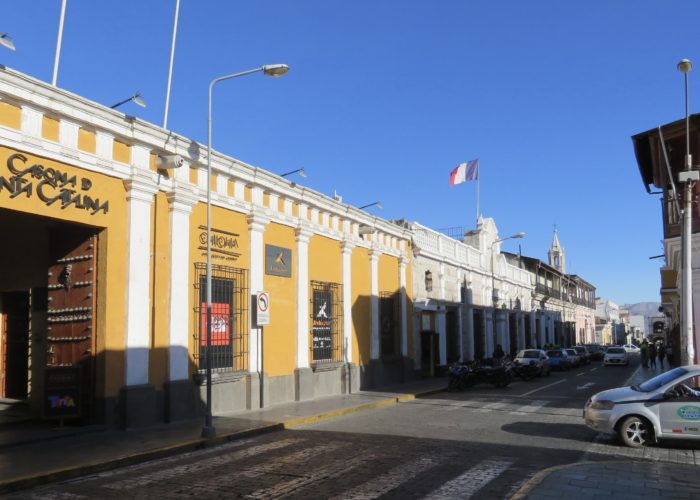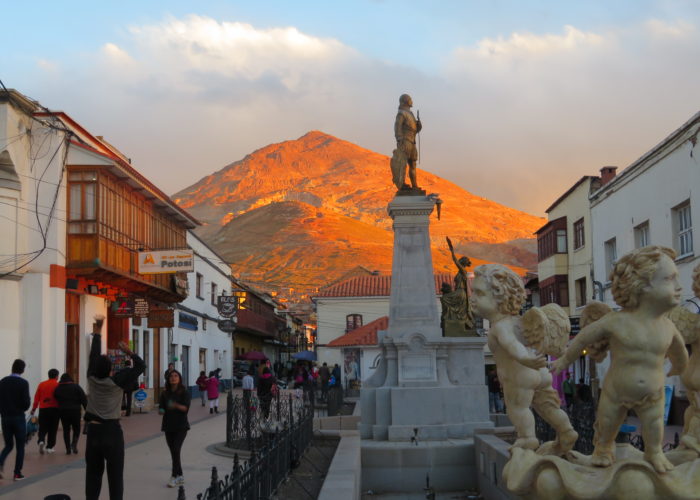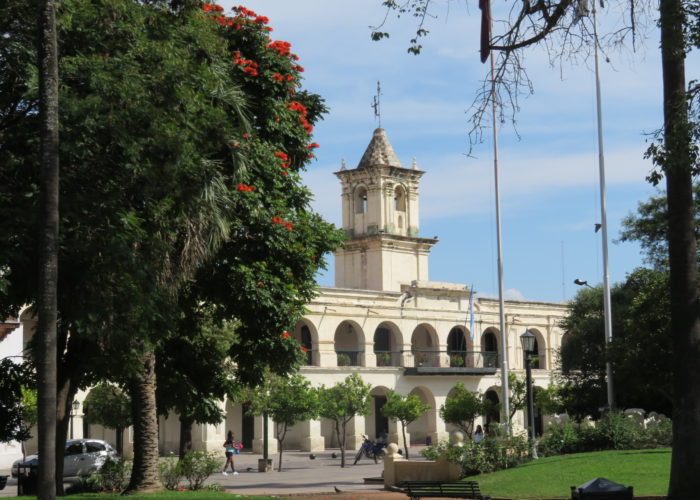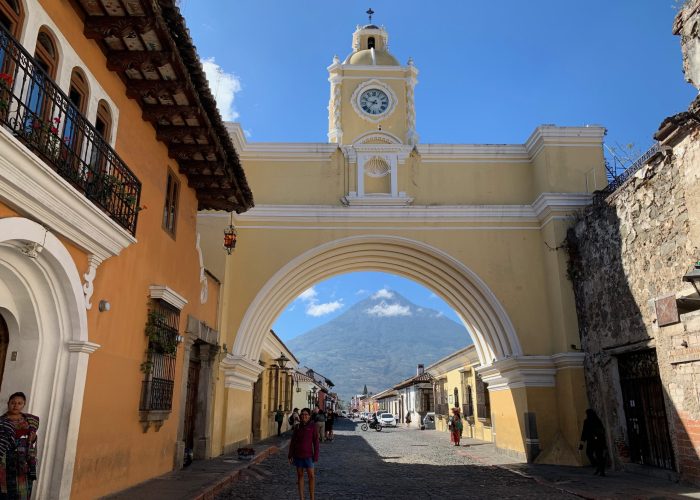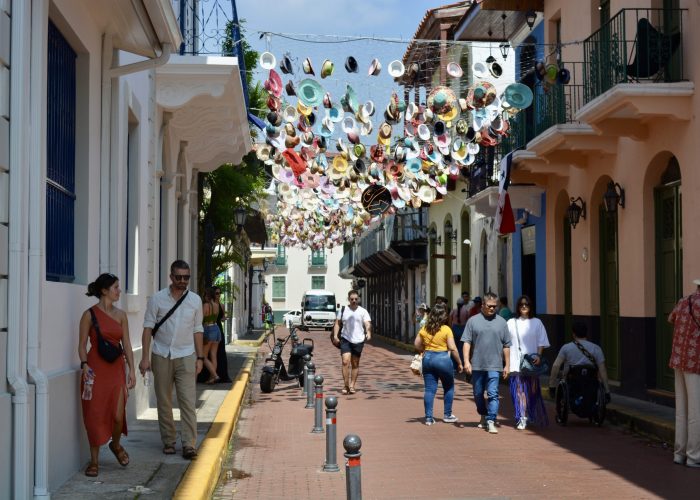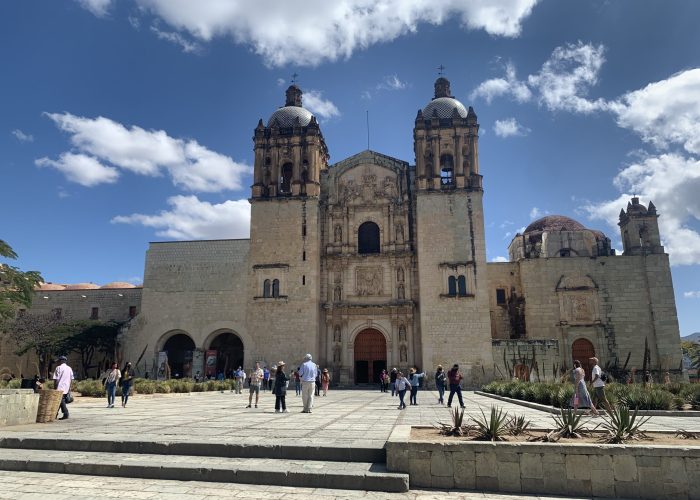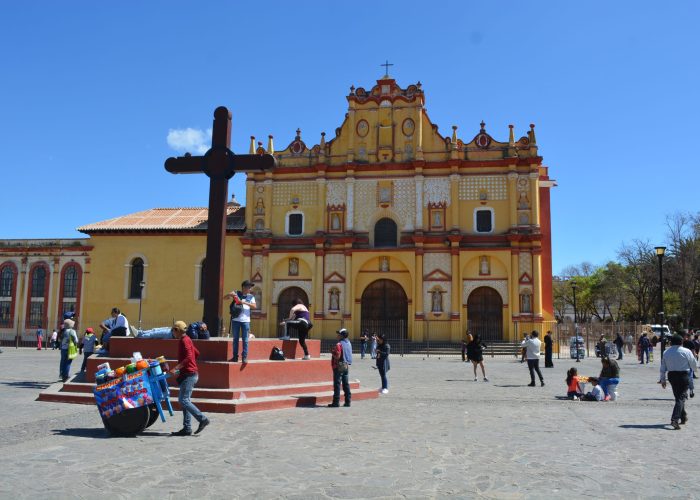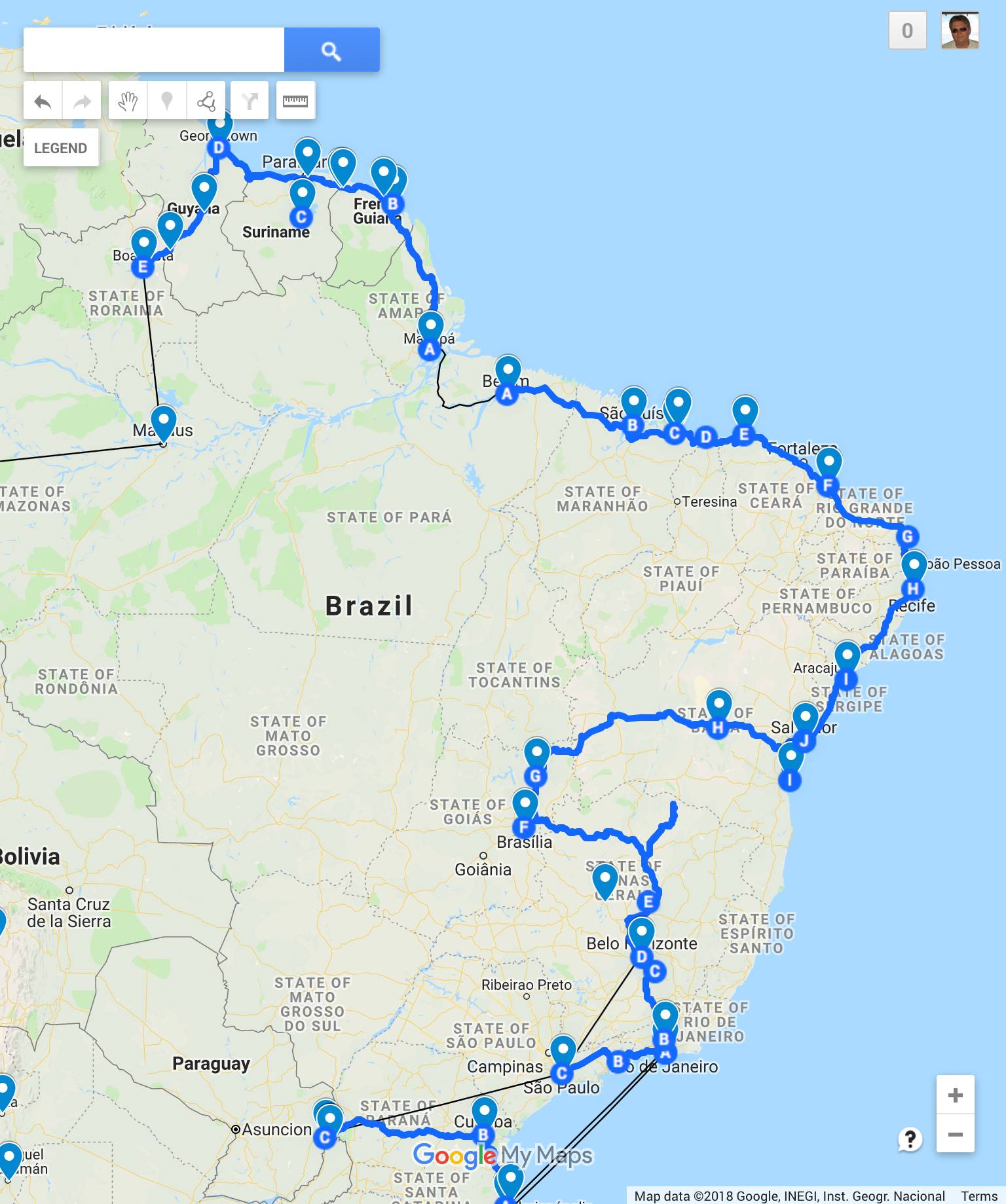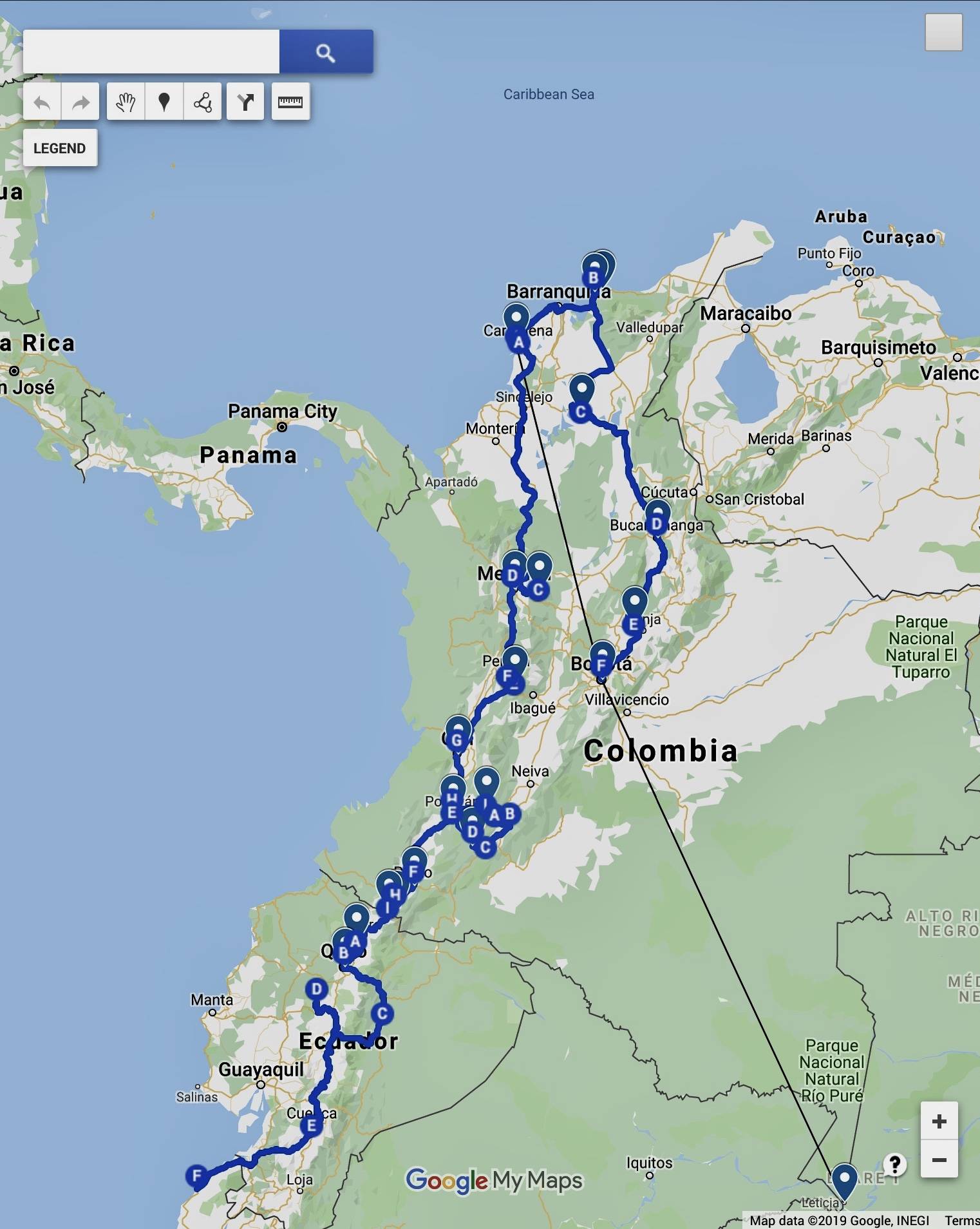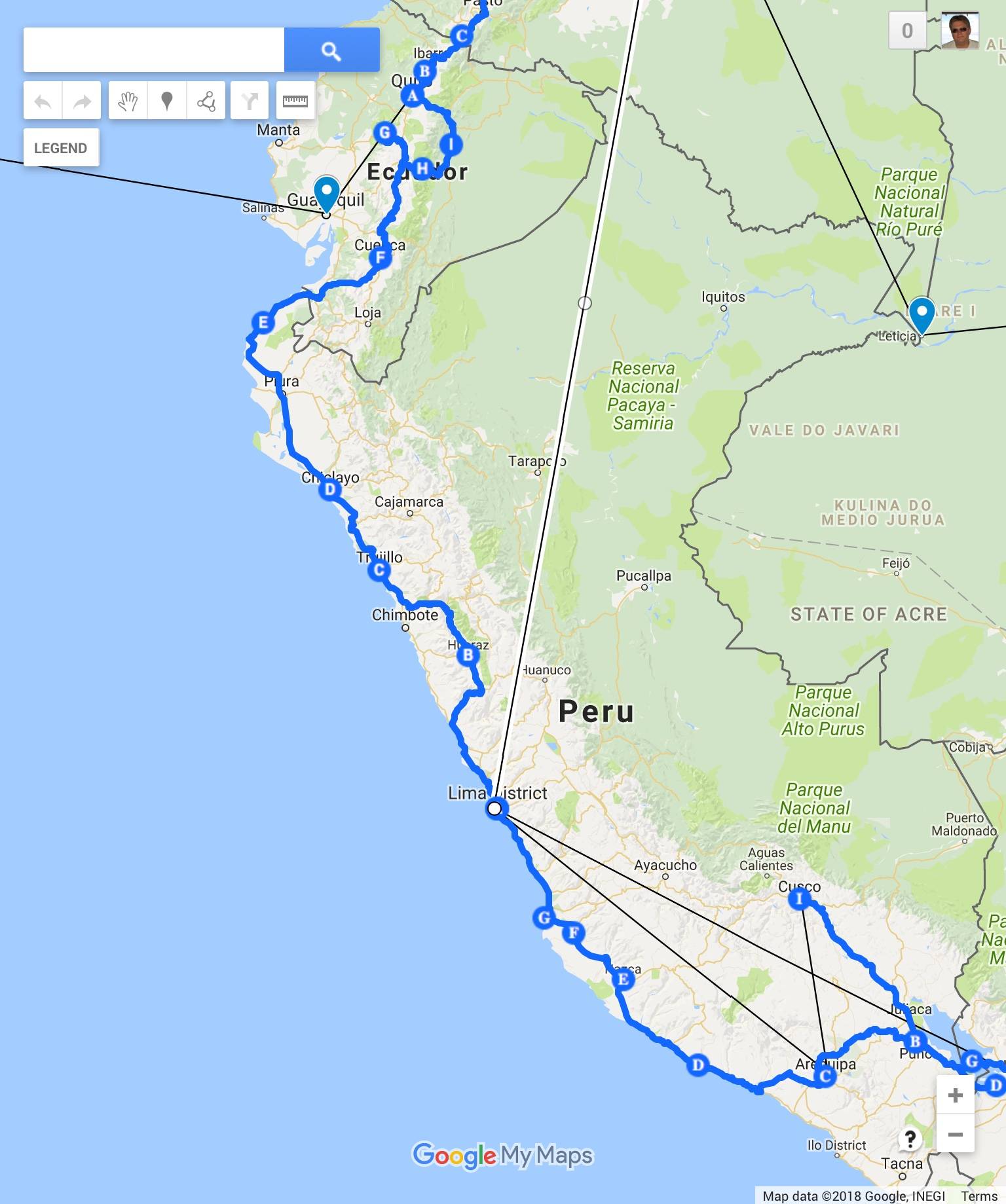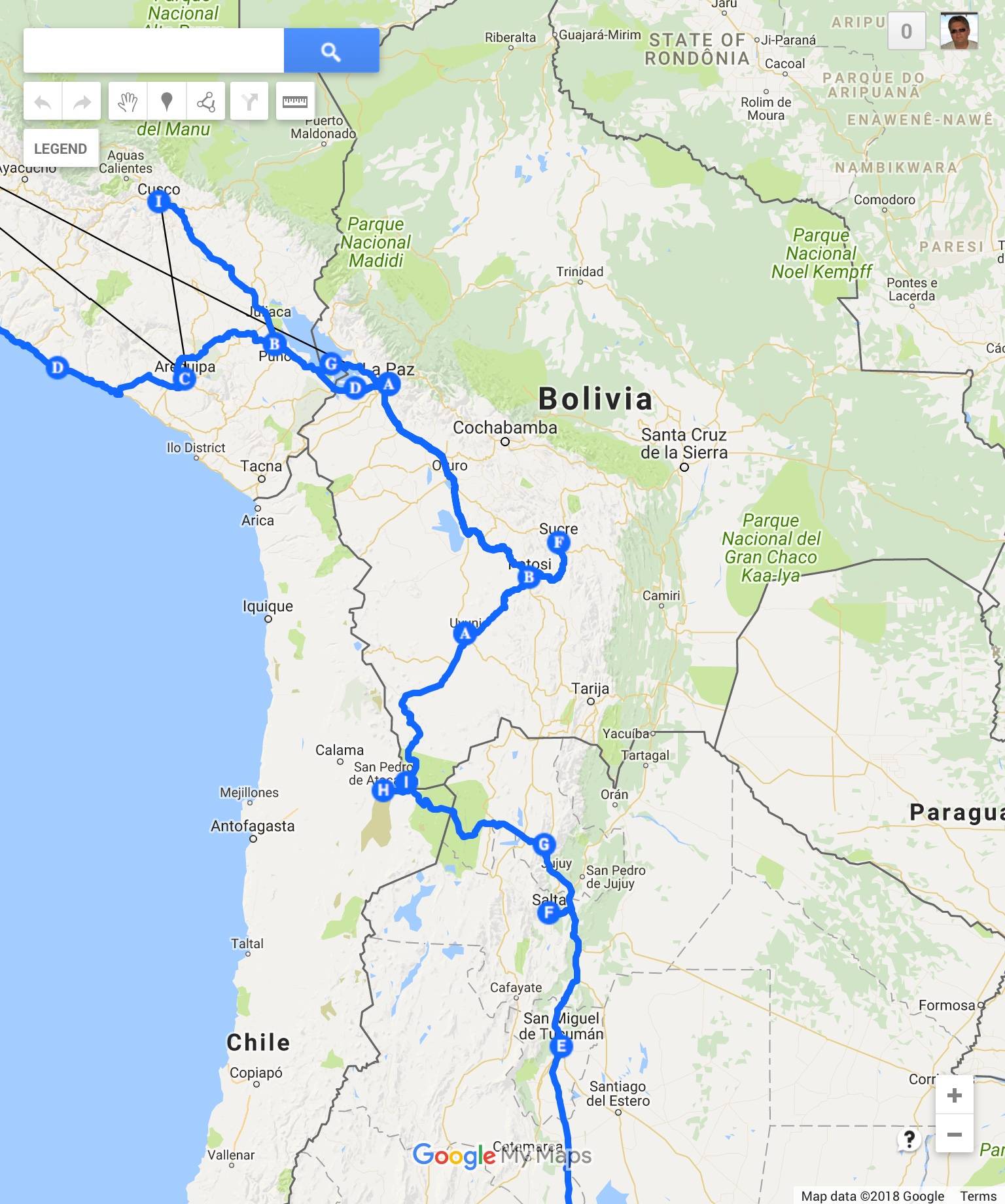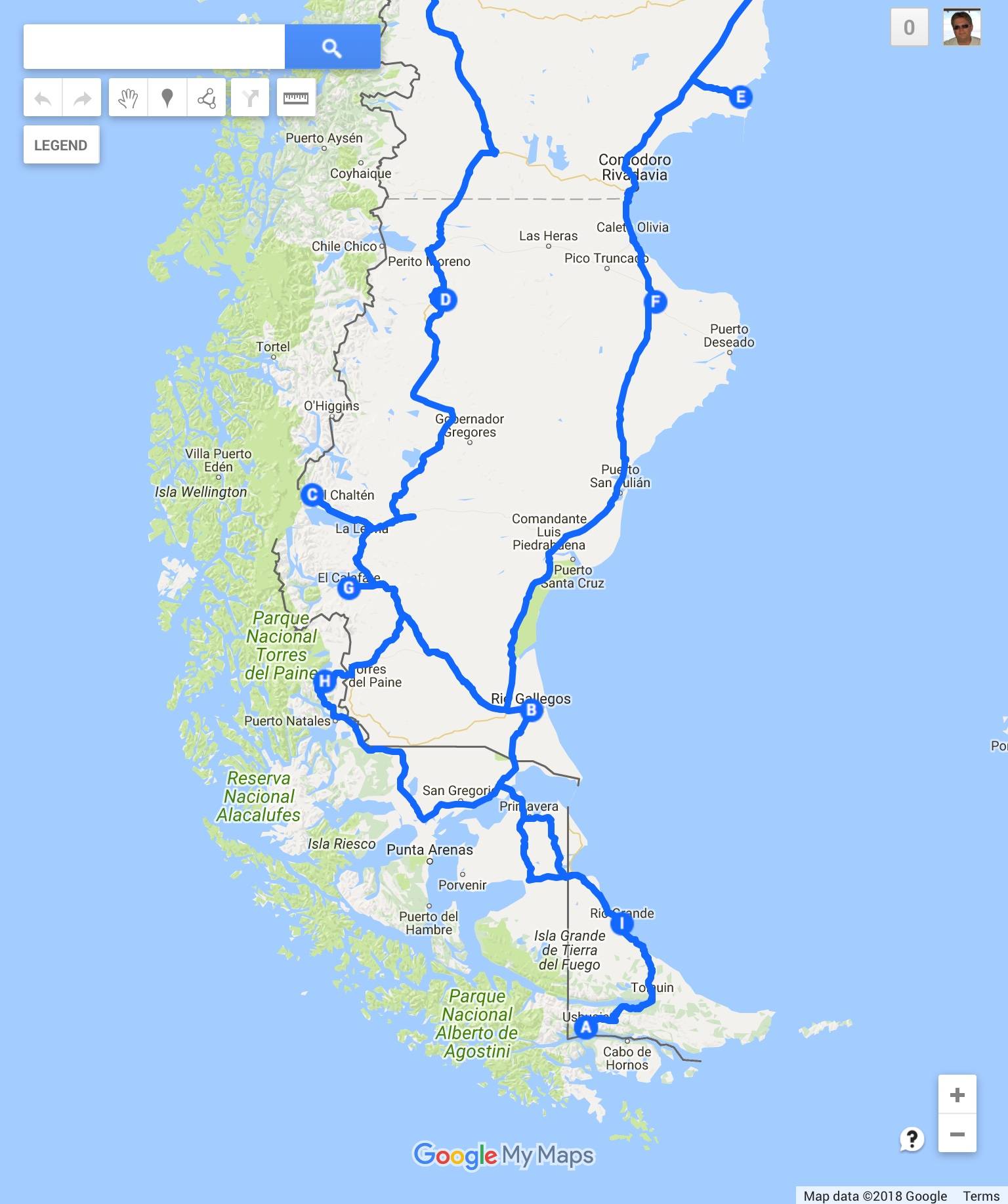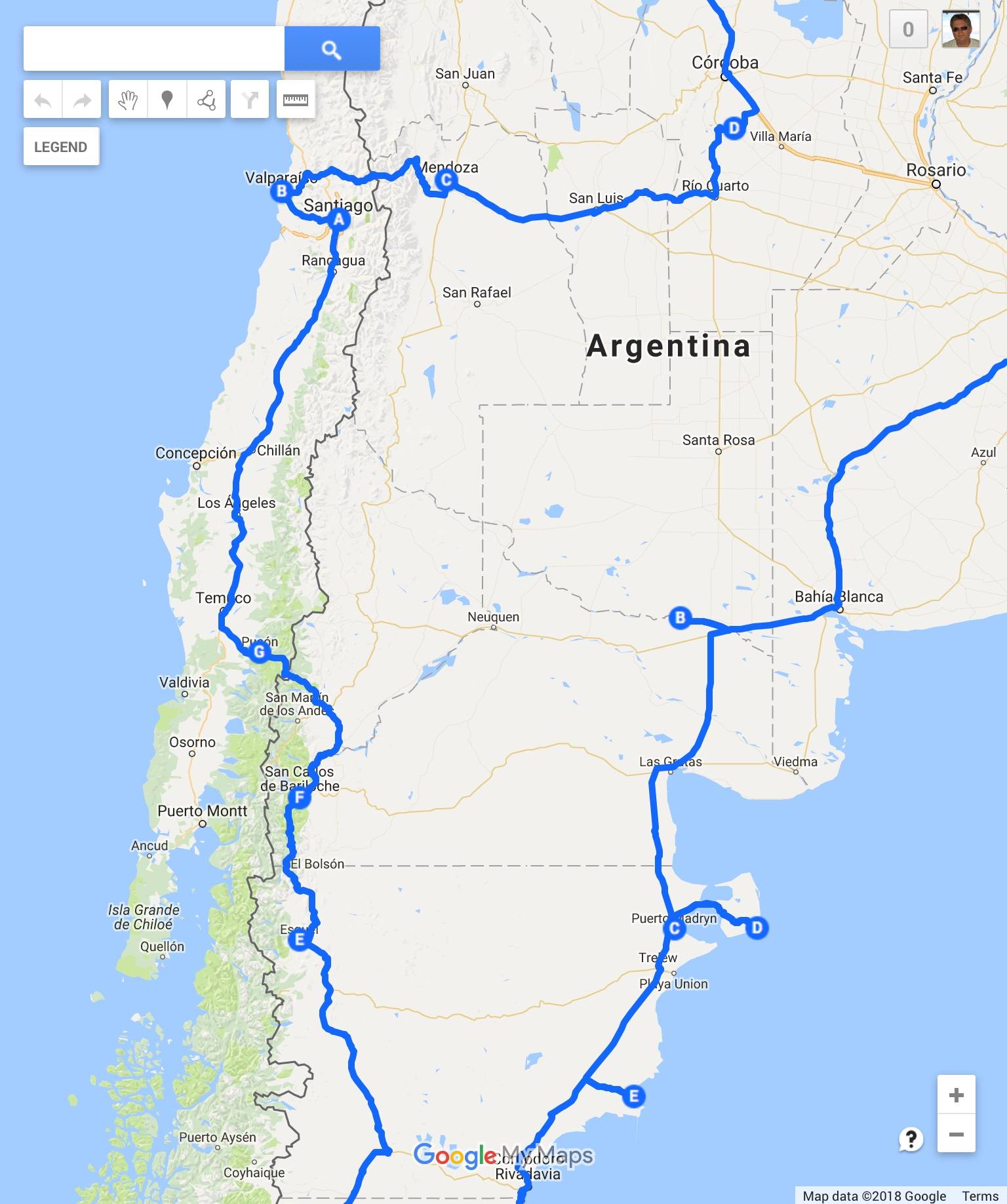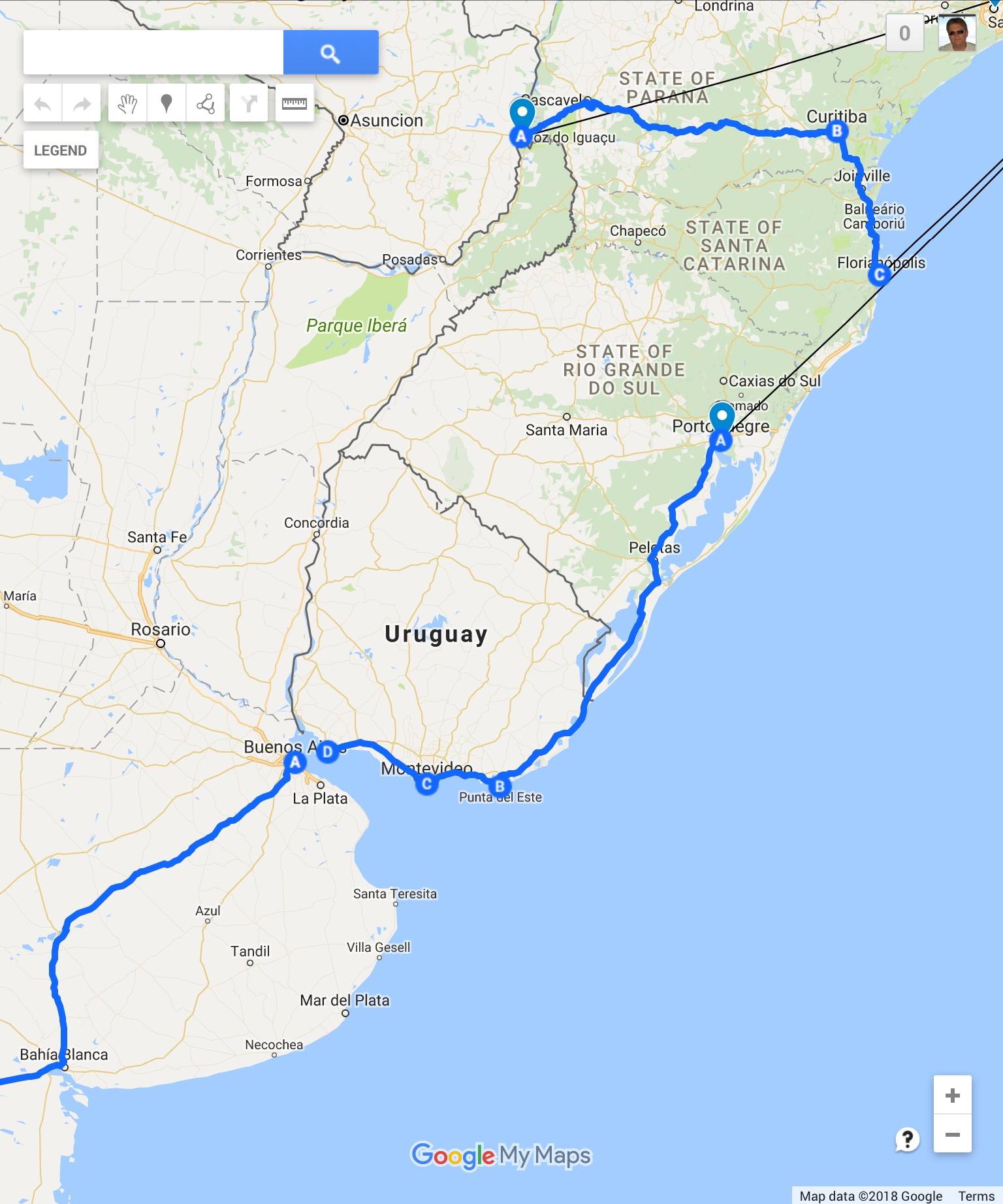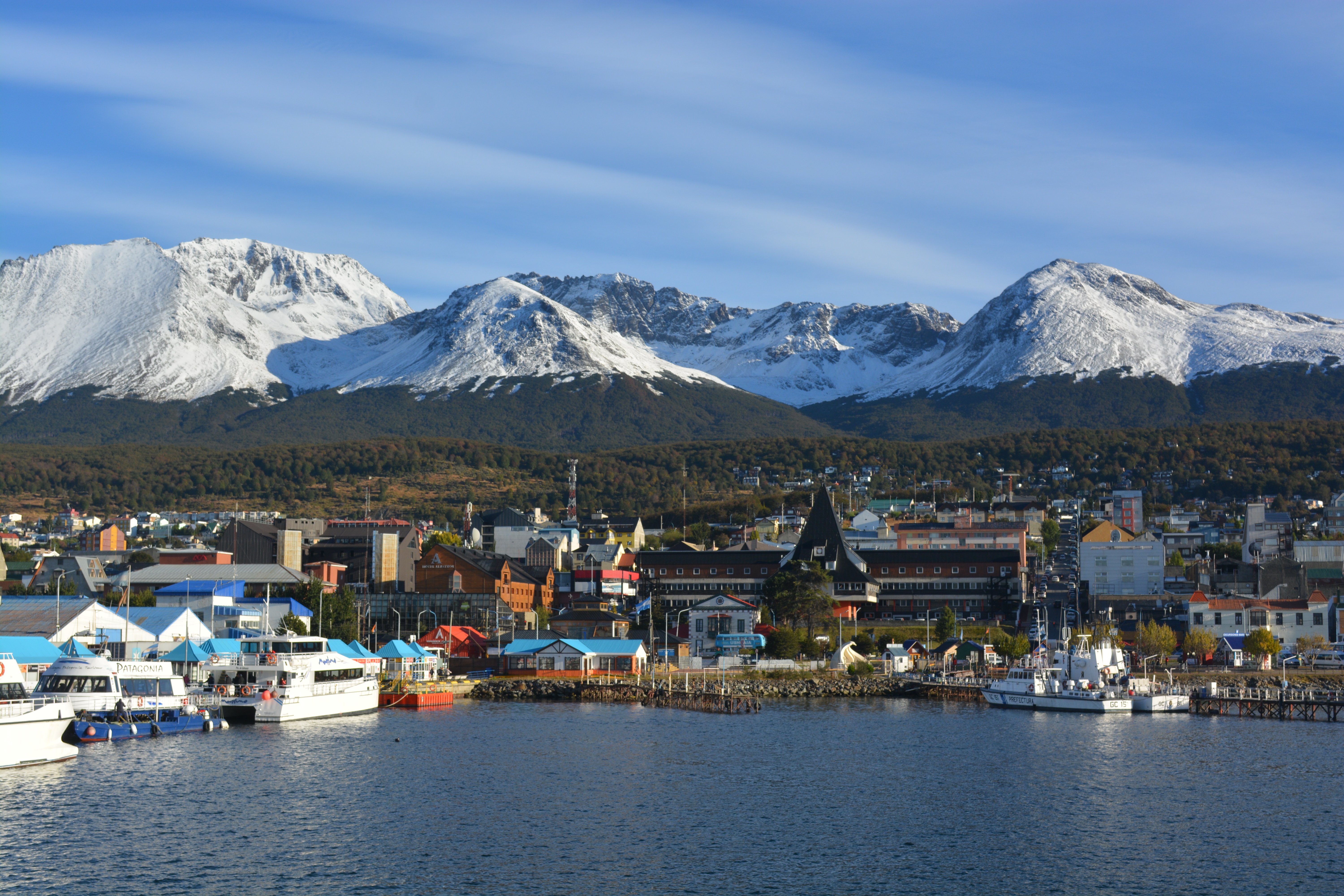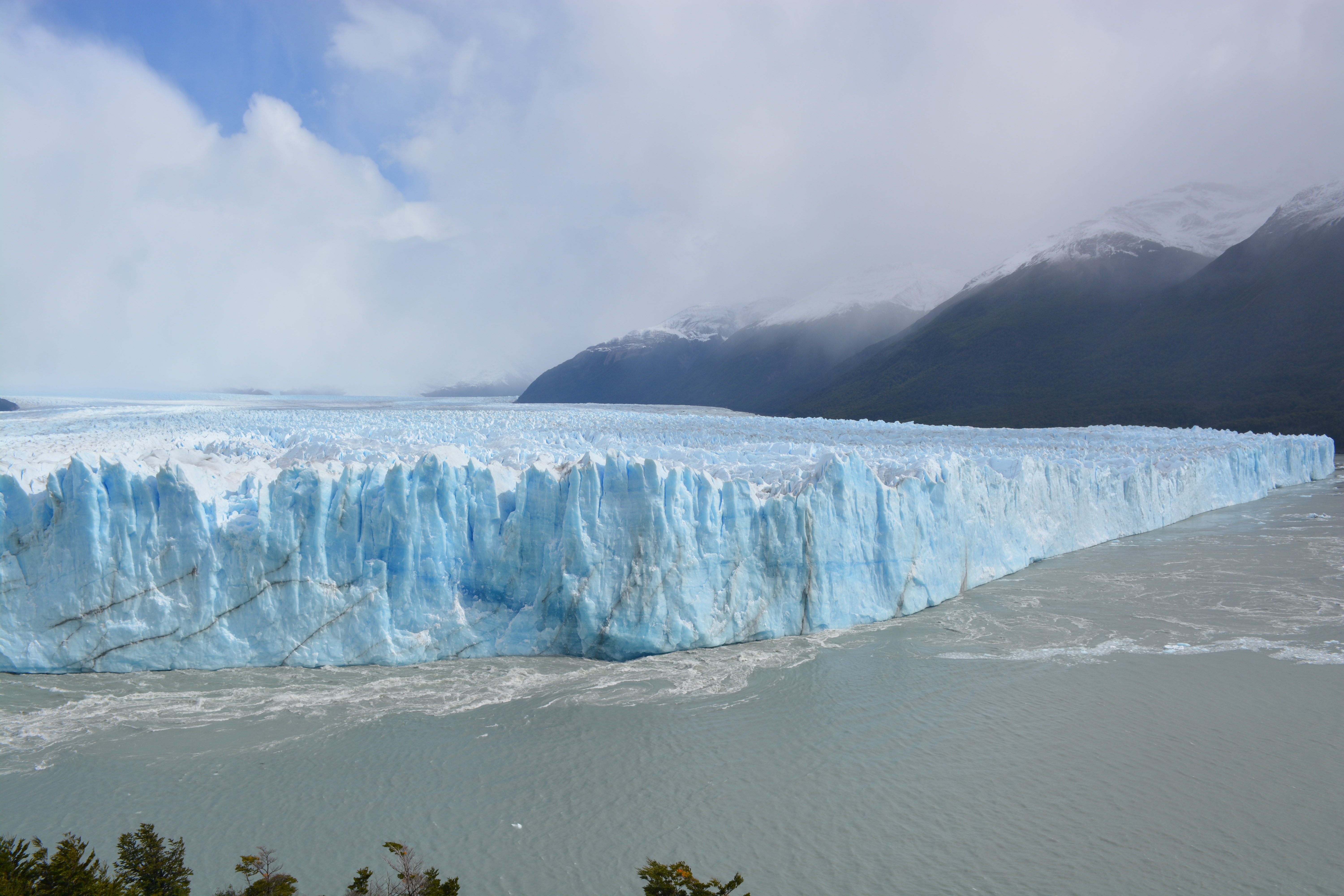Welcome to Our Travel Journey: Latin America & Beyond
1. Our Journey
Over the years we have travelled extensively but in 2018 after a career in finance and technology we decided to pack the house up and spend a year travelling in South America. The particular attraction of Latin America stems from my family history, as my mother was born in Bogotá, Colombia and spent her childhood there, and then in both El Salvador and Guatemala. Growing up hearing stories from her and my grandparents of life in Latin America in the 1930s through to the 1960s helped create the desire to travel the length of the Pan American Highway and see the countries for ourselves.
Our first trip to Latin America was in 1989, when we travelled to both Colombia and Ecuador. At that time Colombia was going through major security problems, and while at the time we may have been rather naïve, we experienced a country that was very welcoming and an incredibly rewarding experience. Subsequently in the region we have had short trips to Argentina, Chile and Brazil in 2006, Central America and Mexico in 2007, Peru in 2011, Brazil for the World Cup in 2014 and Colombia again in 2016.
Travelling for a year overland, we had to learn to plan our route carefully, ensuring that we had sufficient down time during the journey and learn to live with just the stuff we could carry. During our travel journey in South America we employed a variety of techniques, generally finding that for cities and some of the more visited destinations, independent travel on public buses and using companies like Booking.com etc. it was pretty easy to travel, and the flexibility afforded gave us more time to explore places in much more depth. Spending at least a whole week in cities like Buenos Aires, Bogotá etc. we often found that each day was very different, for example traffic free days at weekends etc. In Peru and Bolivia we found the company PeruHop was a very good and practical alternative to public buses, with the added advantage of direct pickups from your hotel / hostel. For some of the more remote areas and National Parks, such as Patagonia and the Guianas where distances are great and public transport infrequent and often impractical we found using an overland travel company like Dragoman a good option, with the added advantage of a shared travel experience.
Following the lost years around COVID times, we returned to Colombia, a country we are familiar with to see how independent travel has changed with all the restrictions of the time and the slow recovery of business. Following our 2022 visit to Colombia, we travelled through the Southern part of Mexico in 2023 and then from Panama to Guatemala in 2024, thereby completing parts of the North American legs of the Pan American Highway.
2. Quick Travel Stats
- Countries Visited (covered by these blogs): 18 (74 UN Countries in total)
- Distance Travelled in 2018: Over 59,000 km
- Airplane 24,074 kms
- Road 35,623 kms
- UNESCO Sites visited in Latin America: 49
- Land Borders Crossed: 35
3. South America Highlights
South America is one of the most diverse continents in the world which has so much to offer any traveller, including both the Andes and the Amazon which make a dramatic contrast. It has a number of mega world cities as well as some of the finest old colonial gems. Its people are some of the friendliest you can come across and with a bit of effort, it is relatively simple to pick up enough of the basics in Spanish and Portuguese to make your interaction with the locals so much more rewarding.
3.1 Brazil
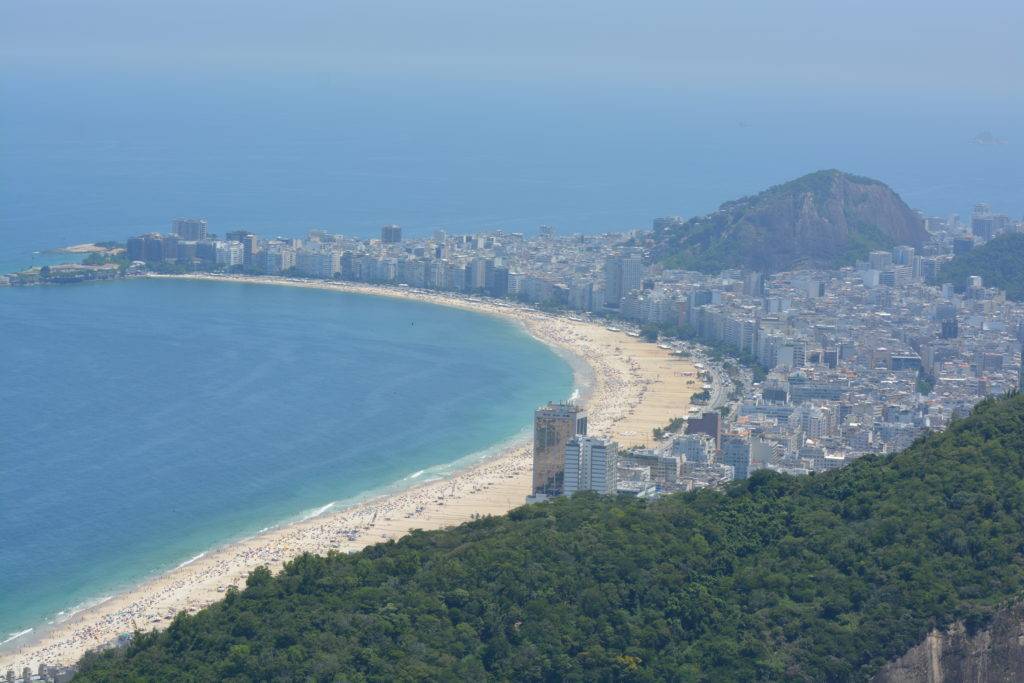



Brazil, a land of vibrant contrasts, offers an extraordinary blend of natural beauty, dynamic cities, and deep-rooted culture. For travellers, it presents an endless array of experiences, from the serene beaches of Jericoacoara, Florianópolis and Praia da Pipa to the bustling energy of megacities like Rio de Janeiro and São Paulo. The country’s vastness allows for a diverse travel itinerary, whether it’s hiking through the towering dunes of Lençóis Maranhenses, exploring the vast Amazon rainforest, marvelling at the Iguazu Falls or soaking up the whirlwind of colour, energy and culture during Rio’s legendary Carnaval.
The force of nature in Brazil is unmatched, with both Iguazu Falls and the Amazon Rainforest offering travellers unforgettable encounters with the wild. Iguazu, on the border with Argentina, stuns visitors with its immense scale and the sheer power of its over 200 individual falls. The roar of the water and the mist rising from the gorge create a dramatic, almost otherworldly atmosphere, making it one of the most captivating natural wonders in South America. Meanwhile, the Amazon, often referred to as the “lungs of the Earth,” offers an entirely different but equally profound experience. Stretching across northern Brazil, the rainforest teems with life—from colourful birds to elusive jaguars. Exploring the dense jungle and winding rivers reveals the richness of biodiversity, leaving travellers in awe of the planet’s largest tropical rainforest.
Beyond its natural wonders, Brazil is home to rich historical and cultural experiences. In cities like Ouro Preto, Olinda, Diamantina, São Luís and Paraty, travellers encounter well-preserved colonial architecture, a legacy of the Portuguese, Dutch, and French influences that have shaped the country’s history. The Afro-Brazilian culture, especially in the north-east, adds a unique rhythm to the streets of Salvador, where the music, food, and religious practices reflect a fusion of African and Brazilian heritage.
Brazil’s modern architecture is another highlight for travellers, particularly in Brasília, the country’s futuristic capital. Designed by the renowned architect Oscar Niemeyer, the city stands as a testament to modernist design, with its striking buildings such as the Cathedral of Brasília and the Palácio do Planalto. Niemeyer’s vision of sleek curves and geometric forms blends perfectly with the surrounding landscape, offering visitors a unique insight into 20th-century architecture. Other cities, like São Paulo, Curitiba etc. are also home to impressive modern structures and showcase Brazil’s dynamic approach to urban design.
Brazil’s culinary landscape reflects the country’s vast cultural diversity, with distinct food traditions across its regions. In the south, especially in cities like Porto Alegre, the churrasco culture reigns supreme, where traditional gaucho-style barbecue celebrates Brazil’s love of beef. Meat lovers can indulge in expertly grilled cuts at rodízio restaurants, where skewers of sizzling beef, lamb, and pork are carved at the table. In contrast, Bahia in the northeast offers a vibrant seafood culture centred around moqueca, a delicious fish stew made with coconut milk, dendê oil, and spices. This Afro-Brazilian dish reflects Bahia’s unique culinary heritage and is served with rice, farofa, and pirão. Together, these traditions showcase the incredible variety of Brazilian cuisine, from the smoky grills of the south to the tropical flavours of the north.
3.2 Colombia
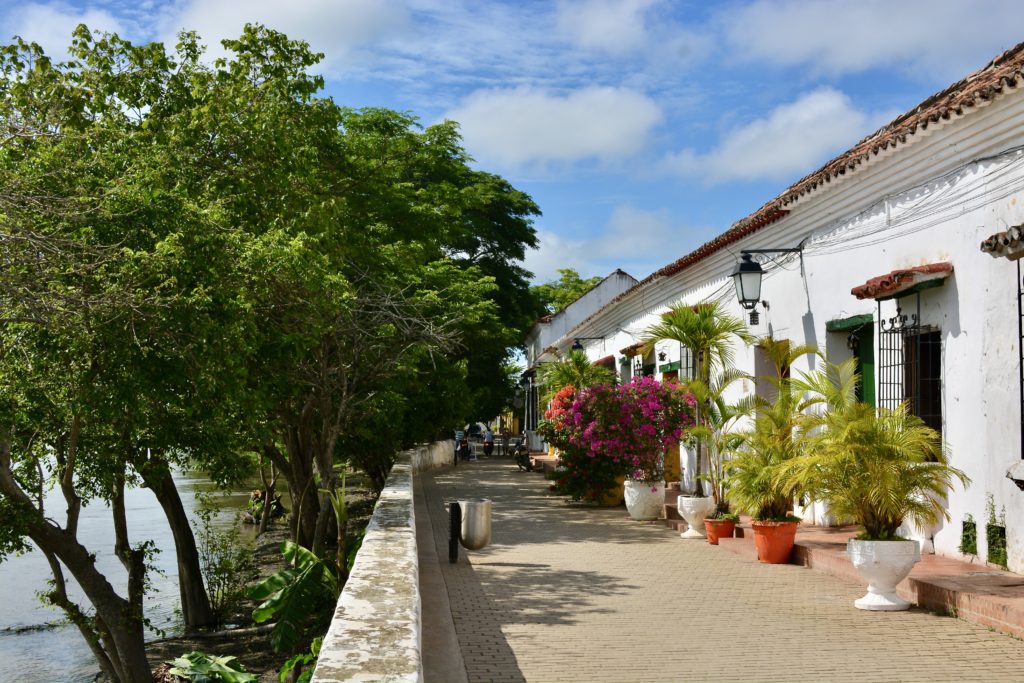
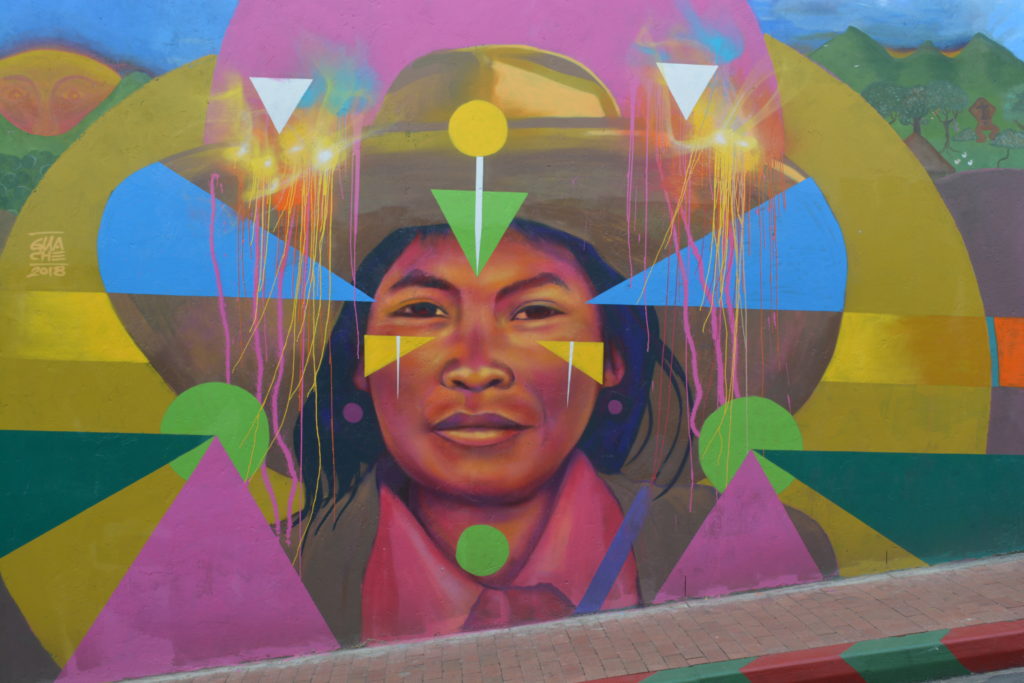
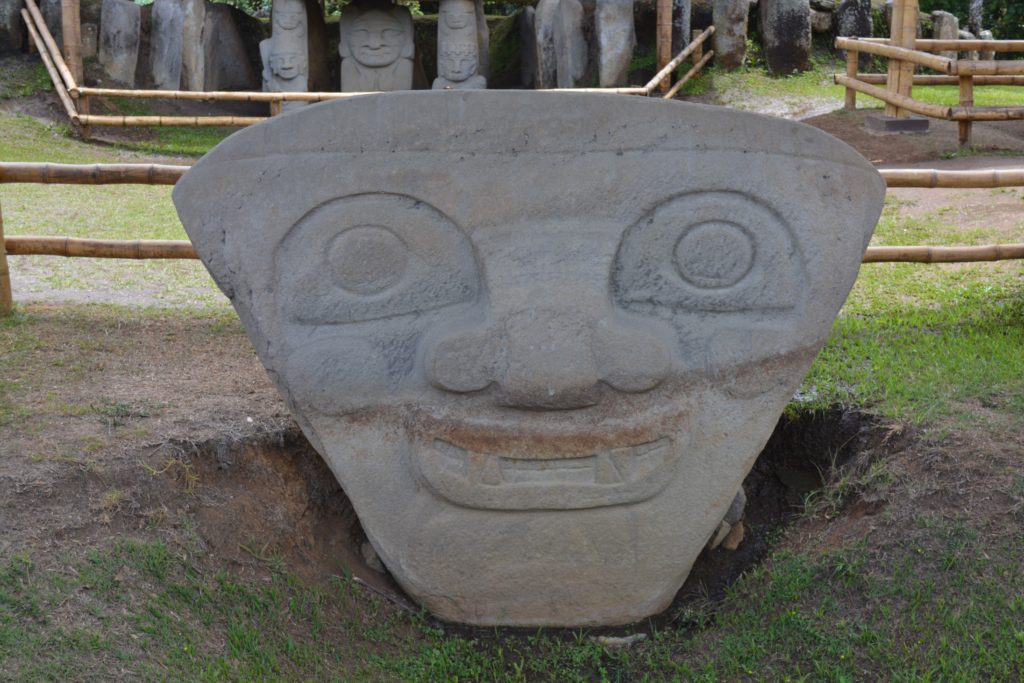
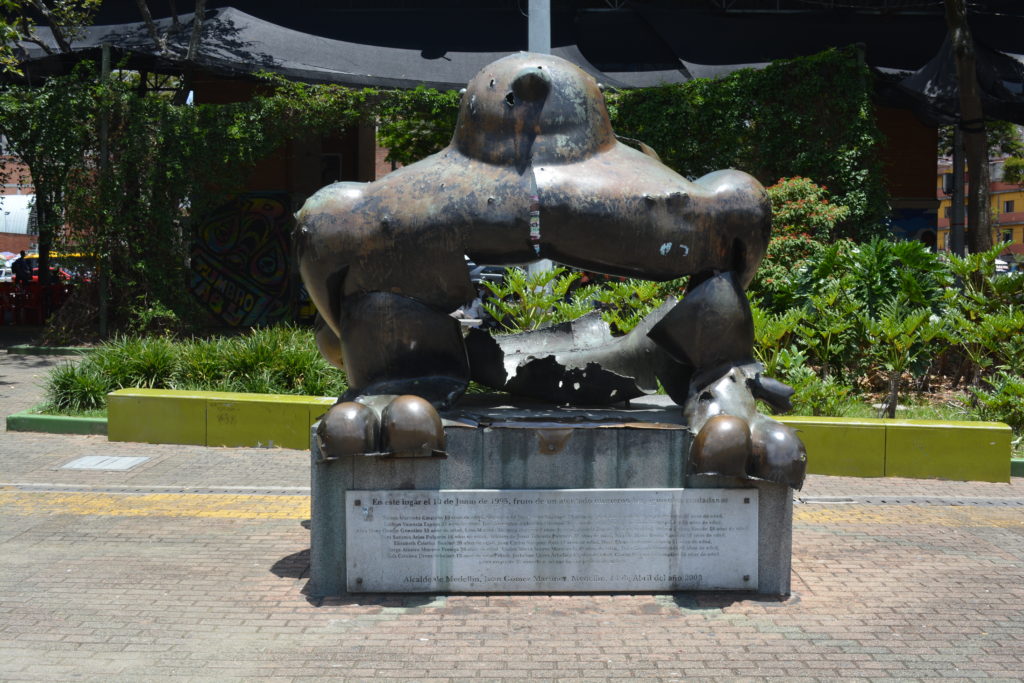
Many frequent travellers to South America will say that Colombia is their favourite destination. While lacking some of the bucket list destinations like Machu Pichu and Rio de Janeiro, Colombia has many destinations just waiting to be discovered. Colombia captivates travellers with its vibrant cities, rich history, and stunning landscapes. Bogotá, the country’s bustling capital, offers a blend of modern urban culture and historical intrigue. Its La Candelaria neighbourhood is a charming mix of colonial architecture, street art, and museums, such as the renowned Museo del Oro. Beyond the capital, Cartagena, with its well-preserved colonial walls and Caribbean charm, transports visitors back in time, while Medellín—once infamous but now a symbol of transformation—offers innovative urban spaces amidst the mountains.
Bogotá and Medellín offer fascinating insights into Colombia’s artistic renaissance. Both cities are hubs of street art, where vibrant murals line the streets, transforming urban spaces into open-air galleries. Bogotá’s La Candelaria district, with its political graffiti and detailed indigenous motifs, and Medellín’s Comuna 13, where murals represent stories of resilience and hope, are must-see street art destinations. Beyond the walls, the artwork of Fernando Botero, with his distinctive style of exaggerated, voluminous figures, is central to both cities’ cultural identity. In Plaza Botero in Medellín and the Botero Museum in Bogotá, his sculptures and paintings are displayed, offering insight into the way he portrayed both humour and social commentary through his art.
Colombia’s landscapes are as diverse as they are beautiful. The country’s natural wonders range from the serene beaches of the Caribbean coast to the misty peaks of the Andes. In the north, Tayrona National Park allows travellers to explore pristine beaches, hike through lush jungles, and encounter wildlife like capuchin monkeys and vibrant birds. Inland, the Coffee Triangle (Eje Cafetero) presents rolling hills filled with coffee plantations, perfect for a tour to learn about the country’s world-renowned coffee production.
In the less travelled south, the archaeological sites of San Agustín and Tierradentro invite travellers to delve into ancient mysteries, with their stone statues and tombs offering a glimpse into pre-Colombian civilisations. In contrast, Leticia in the Amazon region offers a completely different natural spectacle, where the sheer force of nature dominates—from the sprawling rainforest to encounters with unique wildlife
Then there is Mompox, a riverside gem that appears to have stood still for the past 100 years offers a look into Colombia’s colonial past, often evoking the magical realism of Gabriel García Márquez’s novels. Further afield, Popayán offers a quieter, off-the-beaten-track experience, where whitewashed colonial buildings and the surrounding volcanic landscapes offer a serene retreat from the country’s more tourist-heavy regions.
Culturally, Colombia is a vibrant melting pot, deeply influenced by music. Cities like Cali, the salsa capital of the world, and Barranquilla, with its vibrant Carnival, are alive with the rhythms of salsa, cumbia, and vallenato. While traditional music genres continue to thrive in cities like Barranquilla and Cali, modern Colombian music has also made its mark globally, reggaeton has taken the world by storm, showcasing the country’s ability to fuse its musical heritage with contemporary beats. Everywhere you go in Colombia, whether in the bars or on public buses you will hear the rhythms of Colombian music.
When it comes to food and drink, Colombia is a paradise for fruit lovers, offering a staggering variety of exotic tropical fruits like lulo, guava, and pitaya. Coffee culture is also deeply ingrained in daily life, with the Eje Cafetero offering some of the best coffee experiences in the world, where visitors can tour plantations and sample fresh brews while learning about the production process. Colombia never fails to surprise and delight.
3.3 Peru
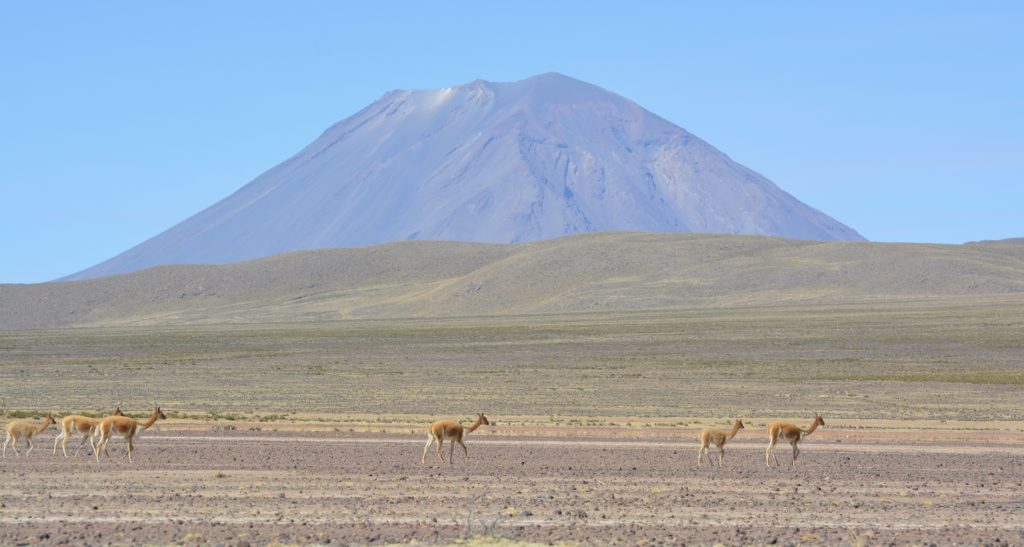
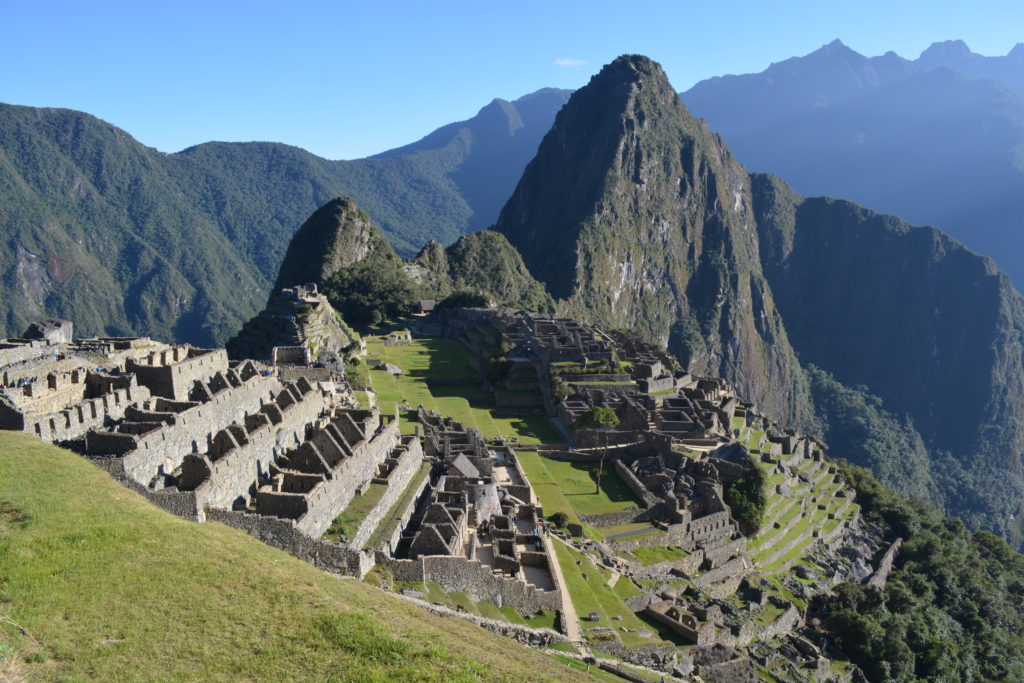
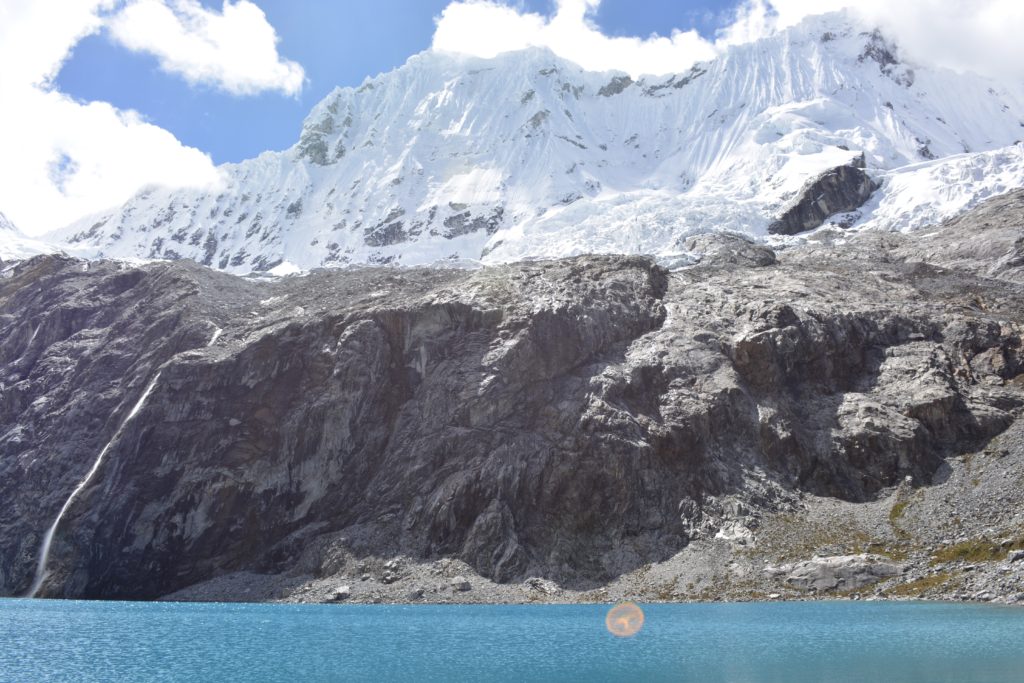
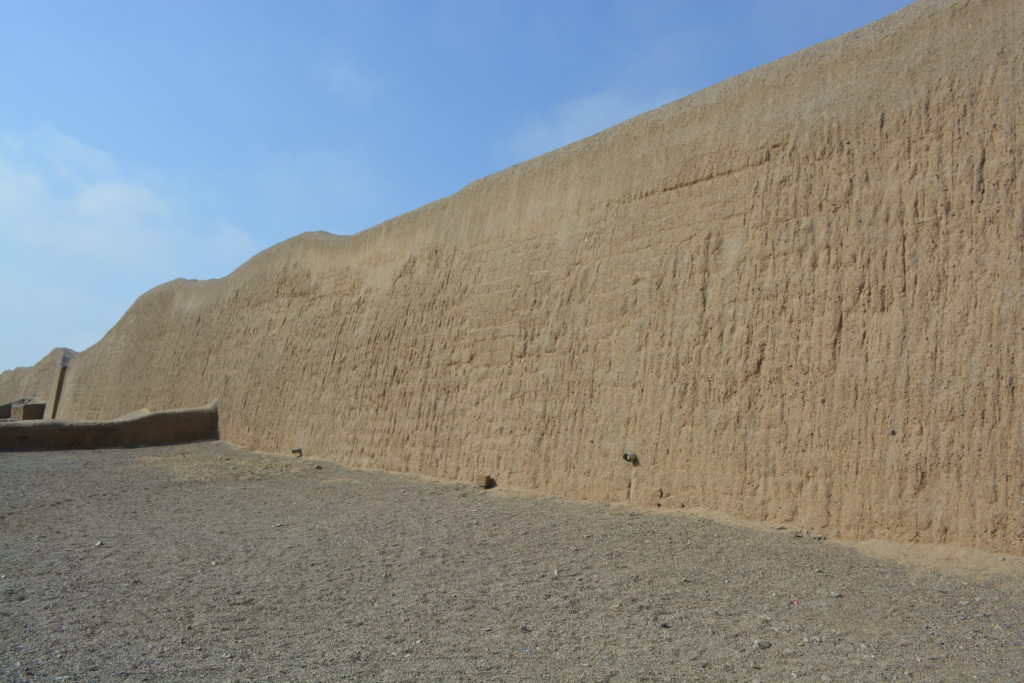
Peru is a land of incredible diversity, where ancient civilisations, dramatic landscapes, and vibrant cultures converge. At the heart of the country lies Cusco, the former capital of the Inca Empire and a UNESCO World Heritage site. Cusco is the gateway to Machu Picchu, one of the most iconic landmarks in the world, nestled high in the Andes Mountains. Travellers are also drawn to Nazca, where the mysterious Nazca Lines, etched into the desert, continue to puzzle archaeologists and tourists alike. Lima, the bustling capital, is a vibrant city with a blend of colonial architecture and modern districts like Miraflores, renowned for its cliffside views of the Pacific.
Arequipa is often said to be Peru’s most charming city, with beautiful colonial buildings set with the spectacular backdrop of Volcan Mist. Nearby is the spectacular Colca Canyon, home to condors soaring above some of the deepest gorges on earth.
For travellers willing to venture off the beaten track, Northern Peru offers a treasure trove of archaeological and natural wonders with far fewer crowds. The ancient citadel of Kuelap, perched on a high ridge, rivals Machu Picchu in grandeur and historical significance. Meanwhile, the massive Chan Chan, the largest adobe city in the world, displays the ingenuity of the Chimú civilisation. The trekking routes in the Cordillera Blanca around Huaraz are equally stunning, with panoramic vistas of snow-capped peaks and turquoise lakes that offer a more secluded experience than the southern trekking circuits. These areas are ideal for adventurous travellers seeking both culture and natural beauty without the crowds.
Peru’s lesser-visited regions also offer an opportunity to experience its vast natural diversity. Iquitos, a remote city accessible only by air or river, is the gateway to the Amazon Rainforest, where travellers can explore its intricate waterways, spot rare wildlife, and learn from indigenous communities. Further south, Chachapoyas opens up access to Gocta Falls, one of the world’s tallest waterfalls, as well as the impressive tombs of Revash, hidden within cliff faces. Travelling these more remote areas of Peru reveals an unspoiled side of the country, rich in natural wonder and cultural heritage, including places like Huanchaco, a surf haven that also preserves a deep connection to Peru’s pre-Columbian past.
Peru’s burgeoning reputation as a food destination is an integral part of its modern identity. The country has become a hotspot for gastronomy, with dishes like ceviche leading its culinary charge. Lima, in particular, has gained international recognition for its blend of traditional and avant-garde cuisine. At the same time, in regions like the Amazon and Andes, visitors can enjoy the unique flavours of local tropical fruits, showcasing Peru’s incredible biodiversity. And no trip would be complete without sampling Peru’s famous coffee, grown in the highlands and appreciated around the world. The country’s indigenous heritage remains a defining aspect of its national identity, reflected in the languages spoken, the festivals celebrated, and the customs practiced throughout its regions.
3.4 Patagonia
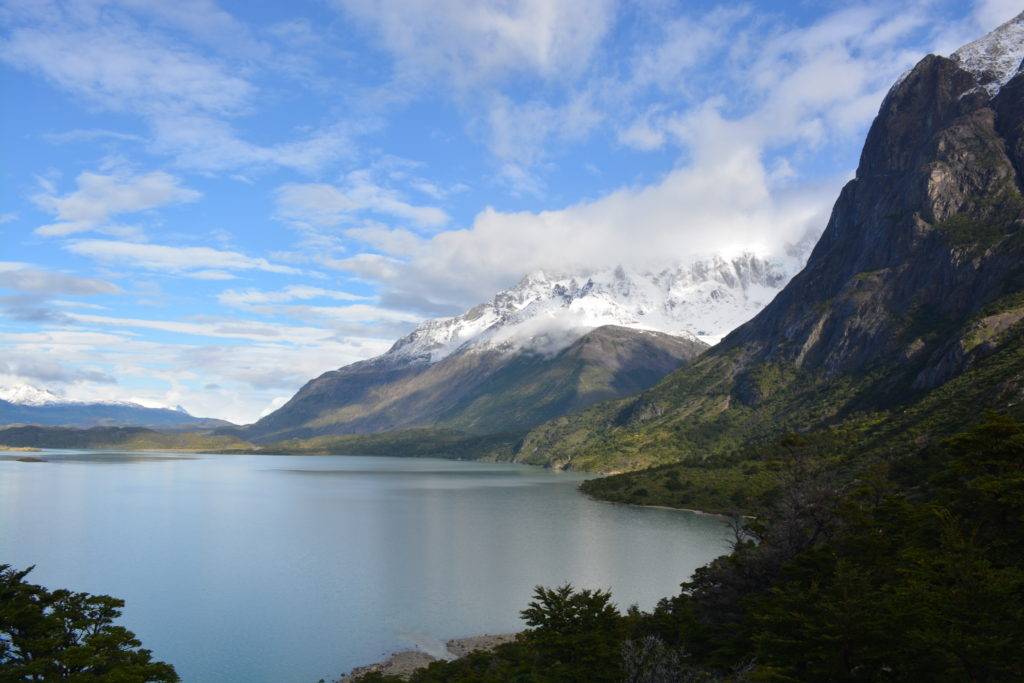
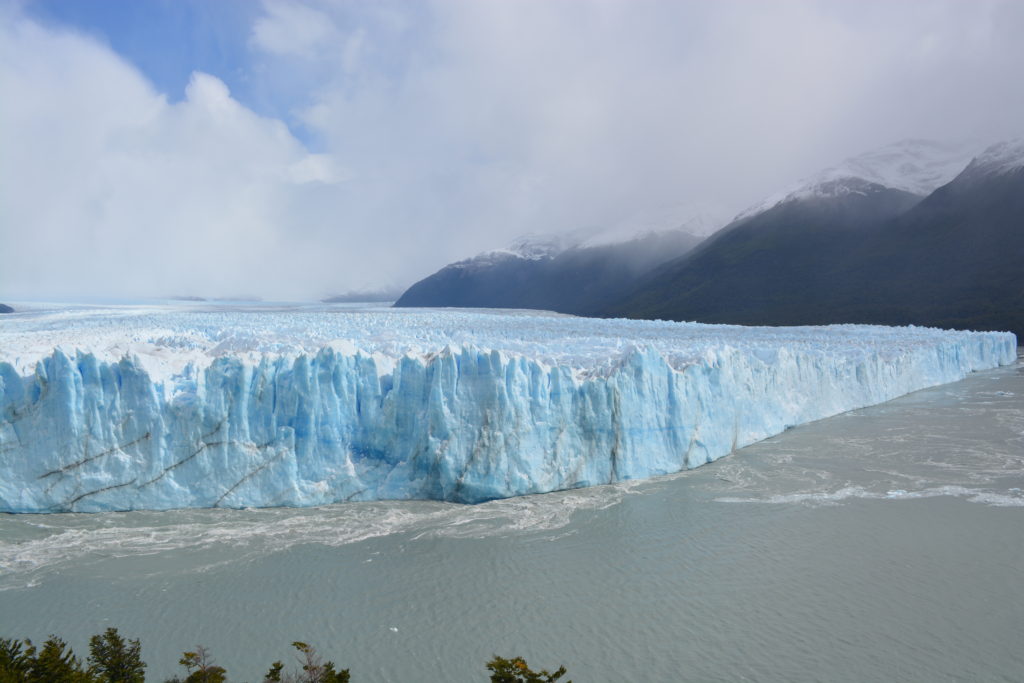
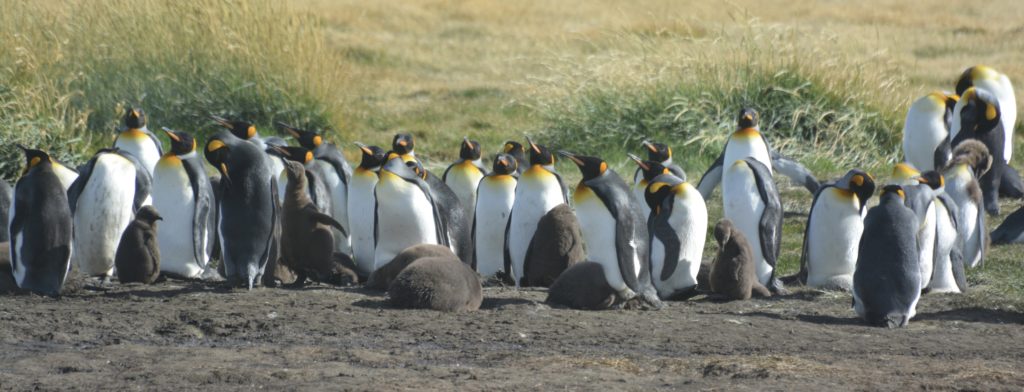
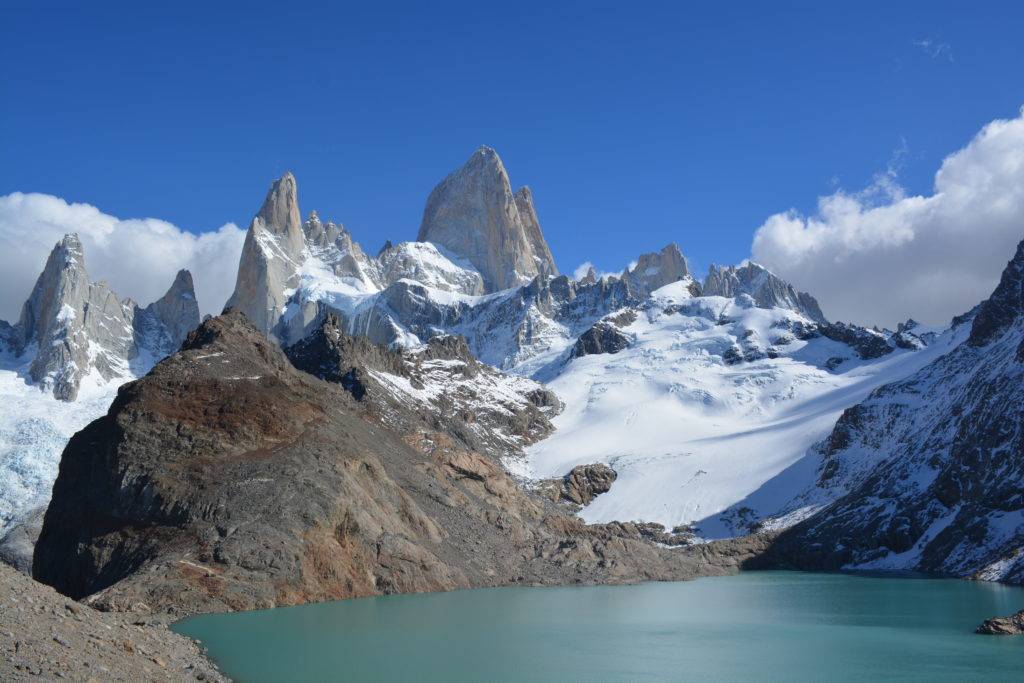
Patagonia, straddling both Chile and Argentina, is a land of dramatic contrasts, from towering mountain peaks to windswept plains. The W Walk in Torres del Paine National Park in Chile is a must for trekkers, offering awe-inspiring views of glacial lakes, jagged peaks, and granite towers. Just across the border, Argentina’s Los Glaciares National Park offers its own spectacular treks, including the famous routes around Mount FitzRoy, whose sharp silhouette rises dramatically above the Patagonian landscape. In Bariloche, also on the Argentine side, the Lake District shines with alpine beauty, while Pucón in Chile is framed by the still-active Volcán Villarrica, a popular spot for adventurers drawn to its volcanic landscapes and outdoor activities.
Patagonia’s southern reaches offer equally mesmerising experiences, including wildlife-rich areas like Peninsula Valdés, where southern right whales, sea lions, and penguins can be seen in abundance. The southernmost tip of the continent, Tierra del Fuego, houses one of the few King Penguin colonies accessible on mainland South America. The Beagle Channel, explored by the famous Charles Darwin aboard the HMS Beagle alongside Captain Robert FitzRoy, is still a draw for modern explorers, while those tracing the footsteps of earlier navigators can learn about Ferdinand Magellan, who first ventured into these straits over 500 years ago.
This region’s rugged beauty is matched by its rich cultural and historical narratives. Puerto Madryn is not only a haven for marine life but also a gateway to exploring the Welsh heritage that remains in Patagonia. The region also continues to evoke the spirit of exploration. Darwin’s observations of Patagonia’s landscapes and its indigenous people, along with FitzRoy’s early charting of the Beagle Channel, have left a profound impact on how we perceive this frontier land. From the windswept plains to the snow-capped Andes, Patagonia’s blend of natural wonder and human history creates an irresistible pull for those seeking remote and untamed wilderness.
Patagonian cuisine offers a unique taste of the land’s bounty. On the Argentine side, the tradition of asado (barbecue) reigns supreme, particularly with Patagonian lamb, which thrives on the wild grasses of the plains. Meanwhile, in coastal areas like Puerto Natales and Ushuaia, fresh seafood, including king crab, features prominently on the menu. Whether it’s hiking the rugged peaks of Mount FitzRoy, marvelling at glaciers, or tracing the footsteps of explorers, Patagonia offers an extraordinary journey into the heart of nature.
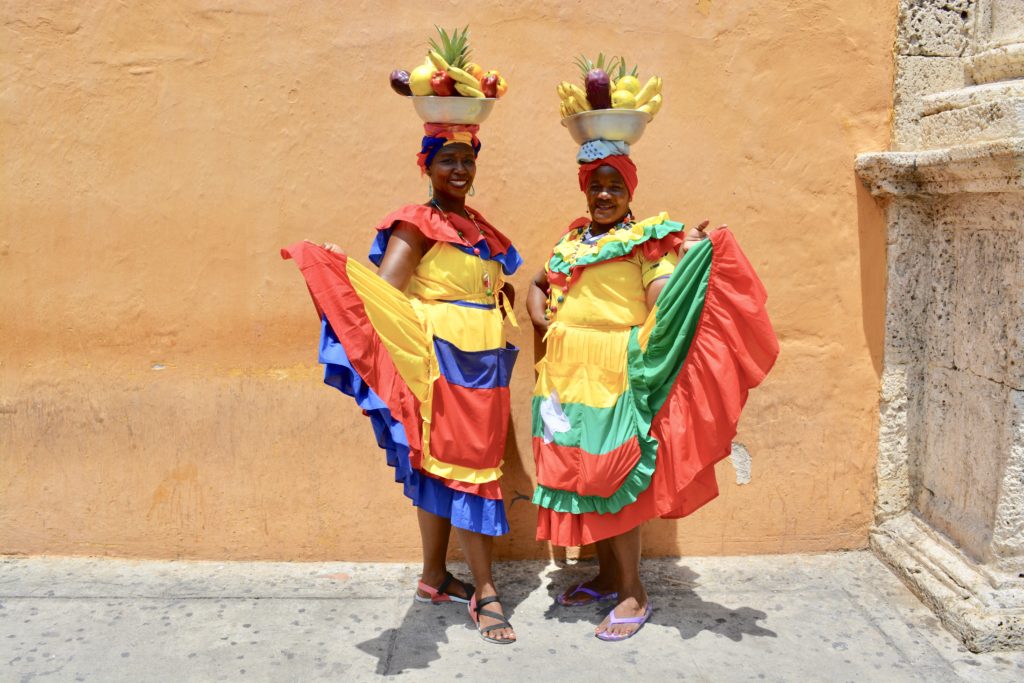
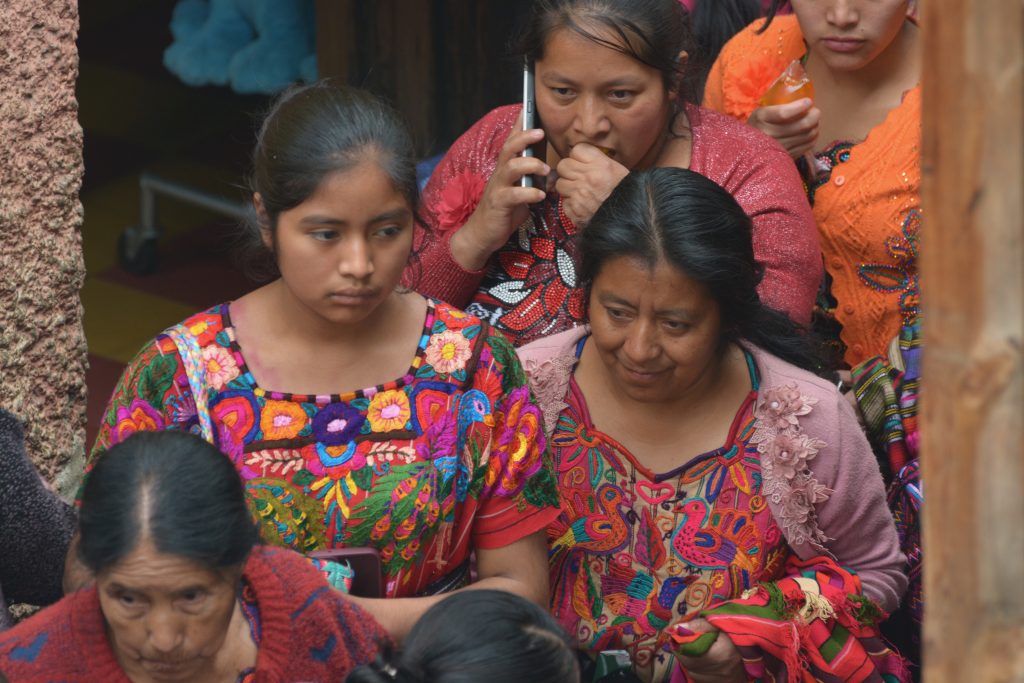
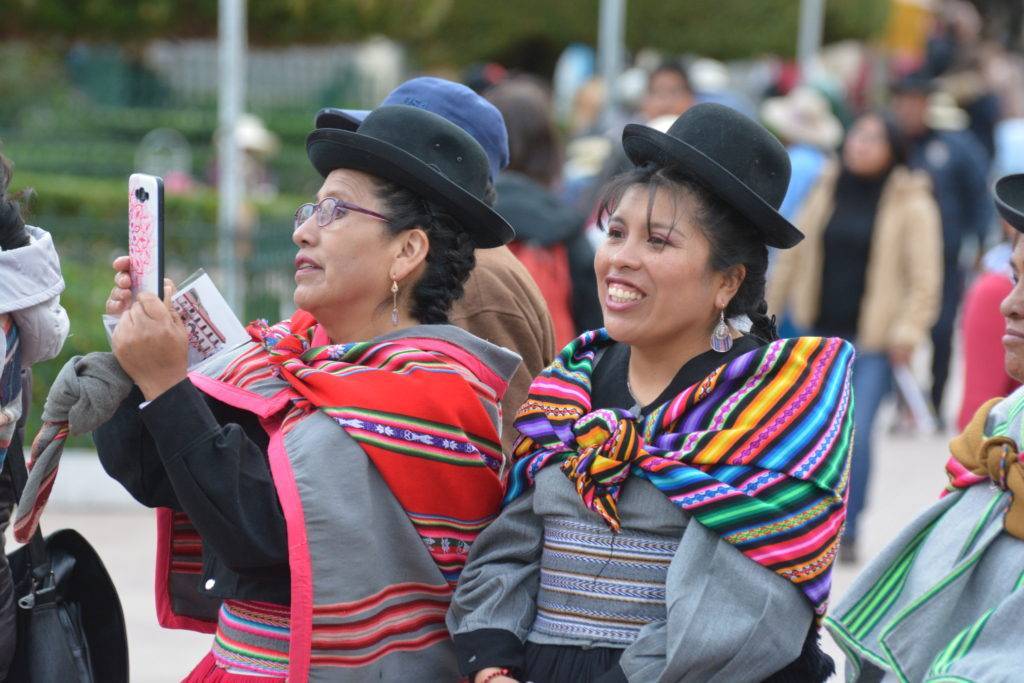

4. Featured Blog Posts
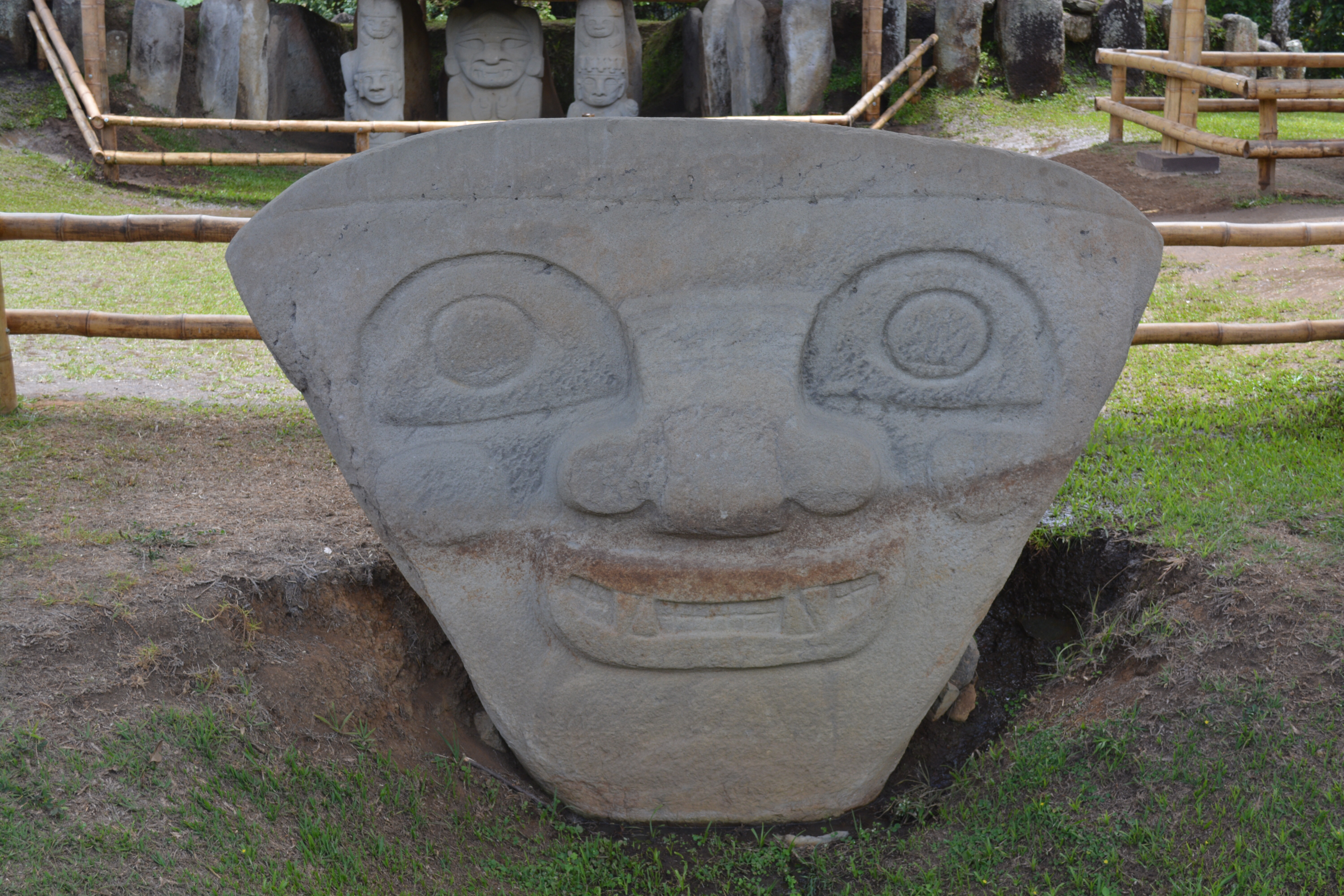
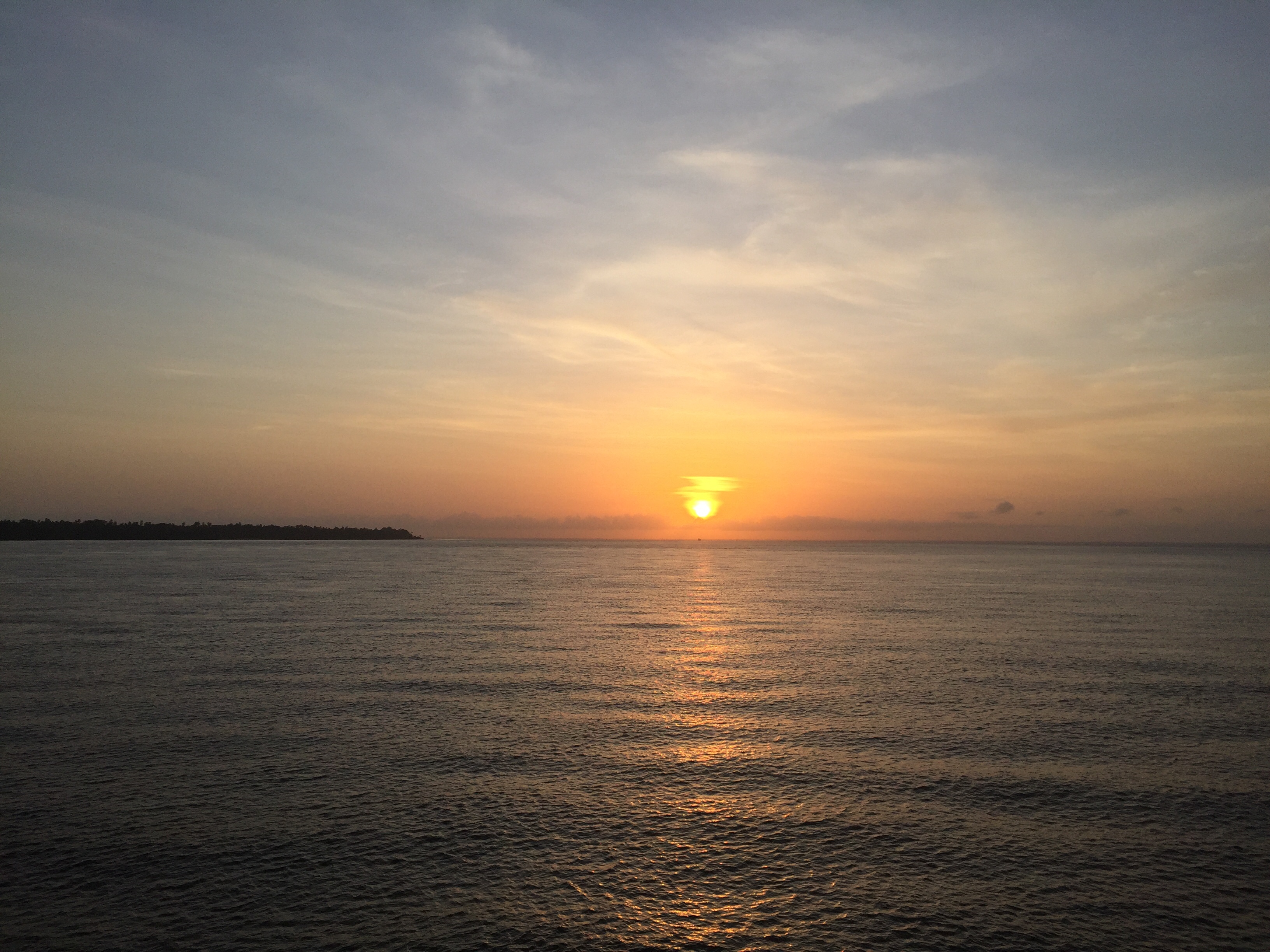

5. Regional Highlights
5.1 Andes & Amazon
The Andes, stretching over 7,000 kilometres from Colombia’s Caribbean coast to Tierra del Fuego, form the backbone of South America and provide a vast array of landscapes for travellers to explore. From the iconic W Trek in Torres del Paine, with its stunning granite towers and glaciers, to the jagged peaks of Mount FitzRoy in Argentina, the Andes offer unparalleled trekking experiences. The Chilean and Argentinian Lake Districts are another highlight, where trails wind through forests and around shimmering lakes, dominated by snow-capped volcanoes like Volcán Villarrica near Pucón. In Peru, the Camino Inca leading to Machu Picchu is a must, though equally rewarding is the lesser-known Cordillera Blanca, home to some of the highest peaks in the Americas. The altitudes on these treks often exceed 4,000 metres, particularly in the Peruvian and Bolivian Andes, where the landscape’s stark beauty is intensified by thin air and deep blue skies.
In contrast, the Amazon is a world of water, stretching over 6,400 kilometres from the Andean highlands to the Atlantic. Starting as a fast-flowing river in the cloud forests of Peru and Ecuador, the Amazon widens dramatically as it winds eastward. At Leticia, which can only be reached by river or airplane, near the borders of Colombia, Peru, and Brazil, the river is already over a kilometre wide. This region is a gateway to pristine rainforests and indigenous communities. Further downstream, in Manaus, the river expands to over 2 kilometres in width, and the city’s bustling markets showcase the incredible biodiversity of the jungle. By the time the Amazon reaches Macapá and Belém near the Atlantic, its channels span a staggering 250 kilometres, as the crow flies, but as the ferry travels winding through the channels some 330kms and 25 hours between Macapá to Belém, a testament to the sheer scale of the world’s largest river system.
The Amazon’s ecological contrast to the Andes is striking. Where the mountains are sharp and barren at their highest altitudes, the Amazon is dense, humid, and teeming with life. This vast region supports a wealth of wildlife, and from Leticia to the heart of Brazil, the rainforest remains one of the planet’s most biologically diverse ecosystems. For travellers, both the Andes and the Amazon offer experiences of immense beauty, yet in completely different environments—each requiring its own form of endurance and preparation.

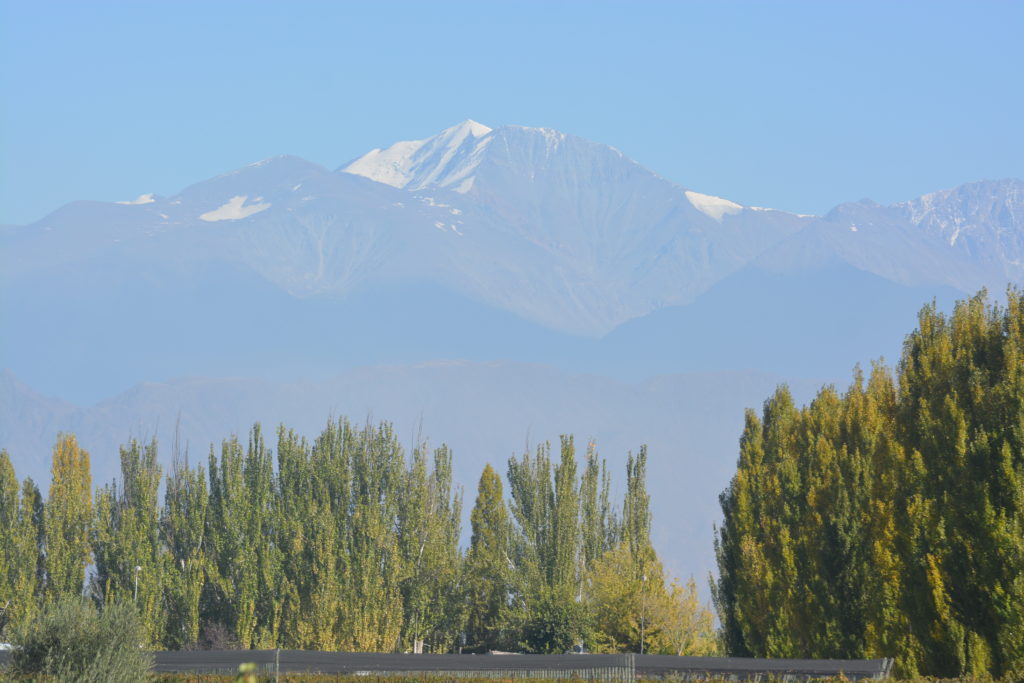

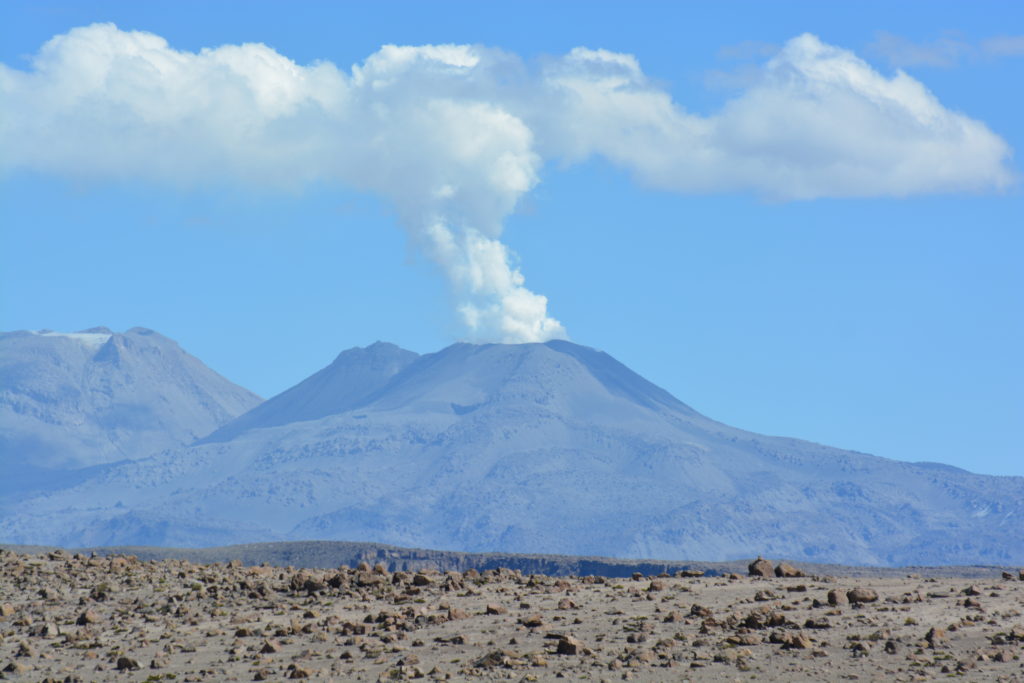
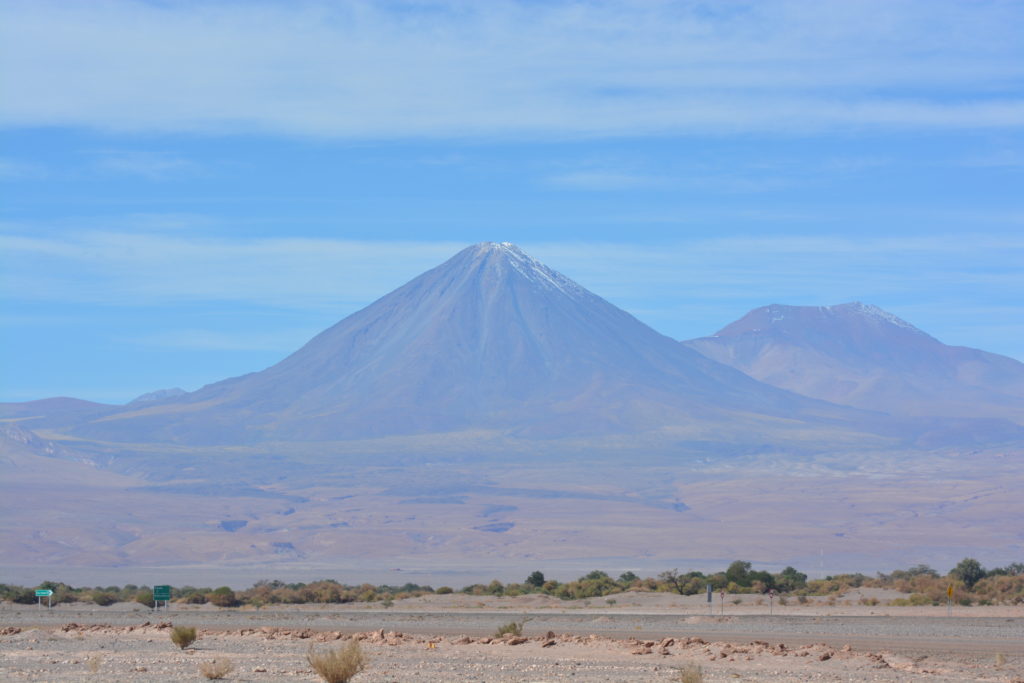
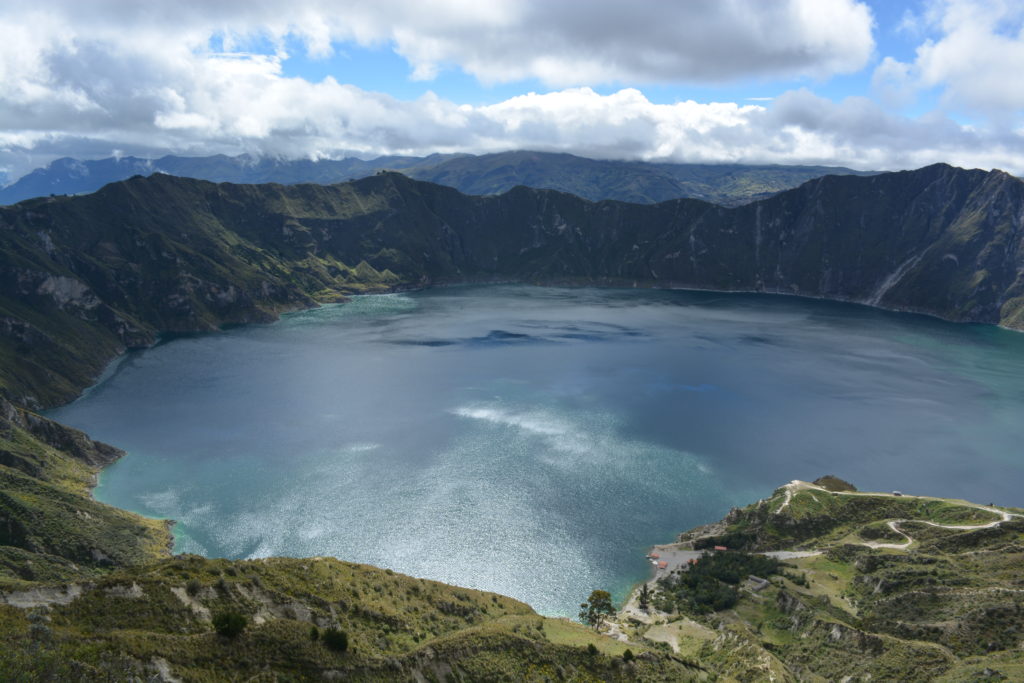
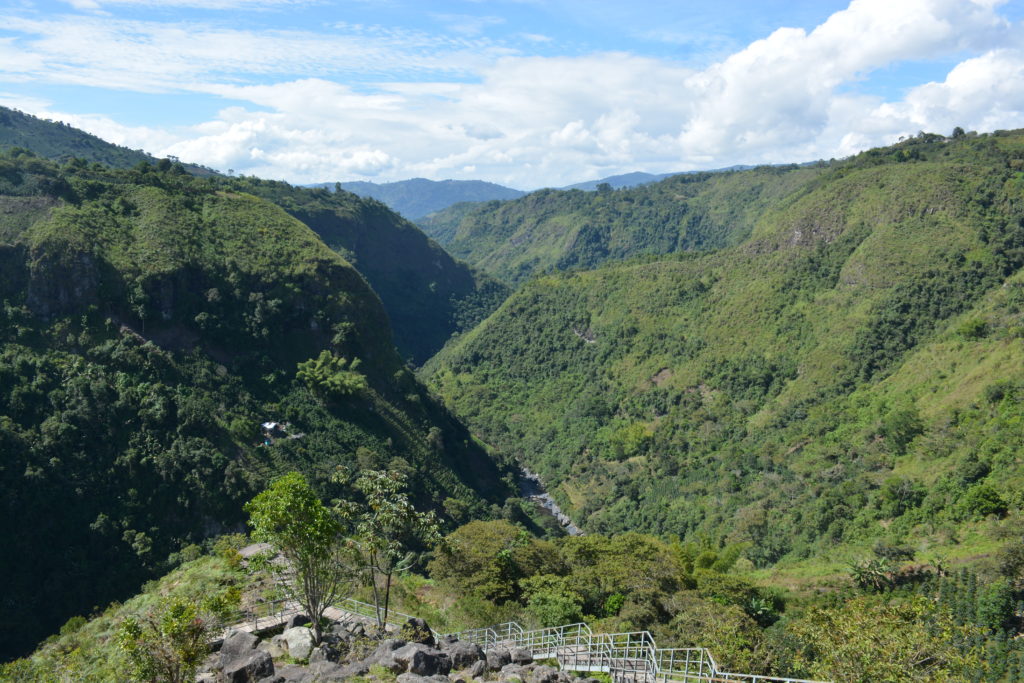

5.2 Waterfalls of Latin America
Latin America is home to some of the most breathtaking and dramatic waterfalls on the planet, with the mighty Iguazu Falls (Cataratas del Iguazú) reigning supreme as the widest of them all. Straddling the border between Argentina and Brazil, its 275 cascades stretch across nearly 2.7 kilometres (1.7 miles) and drop 82 metres (269 feet) at its highest point. The famed Devil’s Throat (Garganta del Diablo) is the most iconic section, where the sheer power of nature overwhelms the senses when it is in full flow. However, the continent’s beauty doesn’t end here. In the remote jungles of Guyana, the Kaieteur Falls plunge a staggering 226 metres (741 feet) into pristine forest. Accessible only by light aircraft, Kaieteur offers a mesmerising display of raw, untouched wilderness and is often considered one of the most beautiful waterfalls in the world.
In Peru, the Cataratas de Gocta, with a total height of 771 metres (2,531 feet), consists of a 540-metre (1,772-foot) single drop, while the Cataratas de Yumbilla reaches an impressive 895 metres (2,940 feet) with its main drop of 400 metres (1,312 feet). Both hidden gems, located near Chachapoyas, offer dramatic descents within the lush Amazonian cloud forest, making them a must for nature enthusiasts venturing into northern Peru. Mexico’s Agua Azul, near the ancient ruins of Palenque, is renowned for its bright blue waters cascading over limestone rocks, with the tallest fall measuring around 30 metres (98 feet), creating a striking contrast with the surrounding jungle. In southern Colombia, the Salto de Bordones, with a drop of approximately 300 metres (984 feet), and Salto el Mortiño, which plunges 180 metres (591 feet), are both situated in the upper reaches of the Magdalena River near San Agustín, providing stunning examples of waterfalls in highland terrain. Together, these natural wonders highlight the sheer diversity of waterfalls across Latin America—from the thundering power of Iguazu to the remote serenity of Kaieteur and the Andean cascades.
5.3 Colonial Cities
In addition to the megacities, South America is dotted with beautiful colonial cities that offer rich historical experiences and stunning architecture. While every large city features its own colonial districts, such as Bogotá’s Candelaria and Montevideo’s Ciudad Vieja, it’s often the smaller towns that captivate visitors.
5.3.1 Brazil
Brazil’s colonial cities are distinct from their South American counterparts, featuring unique architectural styles and vibrant cultural heritage. Salvador de Bahia is a prime example, showcasing Afro-Brazilian culture with its colonial architecture, lively festivals, and historical significance as one of the first colonial capitals. The historic centre of Salvador, with its colourful buildings and cobbled streets, is a UNESCO World Heritage site. São Luís is notable for its colonial heritage, displaying an intriguing mix of Portuguese and indigenous influences through its unique tiled buildings and rich history. Nearby Olinda, known for its historic significance and vibrant Carnival celebrations, boasts well-preserved colonial architecture set against a backdrop of lush hills. In the interior, Ouro Preto and Diamantina are renowned for their baroque architecture and rich mining history, with Ouro Preto being a popular tourist destination due to its stunning colonial buildings and intricate churches. In contrast, Diamantina remains relatively less crowded, offering an authentic experience of colonial life. Paraty, a former port town, features beautifully preserved architecture and a historical ambiance that draws visitors keen to explore its rich cultural heritage.
6.3.2 Colombia
Colombia boasts a rich array of colonial cities that blend history, culture, and stunning architecture. Cartagena de Indias stands out as a jewel on the Caribbean coast, renowned for its well-preserved old town surrounded by impressive walls. The vibrant streets are lined with vividly painted colonial buildings, many of which now house boutique hotels and restaurants, creating a charming atmosphere that comes alive, especially after the day-trippers from cruise ships have departed. Santa Cruz de Mompox, a UNESCO World Heritage site, offers a more tranquil experience with its laid-back charm, cobblestone streets, and rich history as a port town on the Magdalena River. Villa de Leyva enchants visitors with its expansive main square and stunning colonial architecture, making it a popular spot for both tourists and locals alike. Other notable towns include Guatapé, famous for its colourful houses and breathtaking lake views, Barichara, often considered one of Colombia’s most beautiful towns with its well-preserved colonial architecture, Jardín de Antioquia, celebrated for its coffee culture, and Popayán, known for its striking whitewashed buildings and culinary traditions that reflect its historical significance.
5.3.3 Peru and Bolivia
Peru and Bolivia are home to several significant colonial cities that highlight their rich history and cultural heritage. Cusco, once the capital of the Inca Empire, is a UNESCO World Heritage site that reflects a blend of Incan and Spanish colonial architecture. The city’s historic centre features remarkable baroque churches built on the foundations of Incan temples, creating a unique atmosphere that attracts visitors from around the globe. Arequipa, known as the “White City” for its sillar stone buildings, offers a stunning backdrop of volcanoes and is celebrated for its beautiful colonial architecture and vibrant cultural scene. Meanwhile, Potosí, once one of the wealthiest cities in the world due to its silver mines, showcases magnificent colonial architecture that speaks to its prosperous past. The city is a UNESCO World Heritage site, with significant historical landmarks such as the Casa de la Moneda, a colonial mint that played a crucial role in the Spanish Empire’s economy.
5.3.4 Southern Countries (Argentina, Chile and Uruguay)
In the southern regions, Argentina and Chile reveal their own colonial treasures. Salta, known for its colonial architecture and stunning natural scenery, offers a unique blend of indigenous and Spanish influences, while Valparaíso is famed for its colourful hillside homes and historical significance as a major port city. Although Valparaíso’s port area can present safety concerns at night, its artistic vibe and historical charm make it a noteworthy destination. In Uruguay, Colonia de Sacramento reflects a blend of Spanish and Portuguese influences, characterised by its laid-back colonial charm, picturesque streets, and historical sites that contribute to its appeal as a quieter tourist destination.
5.3.5 Central America (Guatemala, Nicaragua and El Salvador)
Central America is home to some captivating colonial towns that exude historical significance and charm. Granada in Nicaragua, with its stunning colonial architecture and vibrant culture, sits on the shores of Lake Nicaragua, boasting colourful façades and colonial-era churches that attract many visitors. León, another Nicaraguan treasure, is known for its impressive churches, including the stunning Cathedral of León, one of the largest in Central America. Antigua in Guatemala, a UNESCO World Heritage site, is renowned for its impressive baroque architecture and a dramatic backdrop of volcanoes. Despite suffering from devastating earthquakes throughout its history, Antigua remains a cultural hub, celebrated for its picturesque streets and vibrant festivals. Suchitoto, located in El Salvador, offers a more off-the-beaten-path experience, retaining its colonial charm amidst cobbled streets, art galleries, and quaint coffee shops, making it a peaceful retreat from the bustling tourist hotspots.
5.3.6 Mexico
Mexico’s colonial cities showcase a rich tapestry of history and culture, with Campeche being a hidden gem on the Yucatán Peninsula. Known for its colourful colonial buildings and fortified walls, Campeche offers a laid-back atmosphere and coastal setting, making it a quieter alternative to larger tourist destinations. Inland, San Cristóbal de las Casas in Chiapas is celebrated for its indigenous culture, lively markets, and well-preserved colonial architecture. Set in the highlands, this charming town combines Spanish and indigenous traditions, attracting visitors with its cool climate and vibrant local culture.
These colonial cities across Latin America present a captivating glimpse into the region’s rich history, architectural diversity, and cultural heritage, making them essential stops for any traveller seeking to understand the depth of Latin American history.
6. City & Street Art Focus
6.1 Megacities
South America’s megacities with populations in excess of 10 million, pulse with cultural energy and dynamic urban landscapes, each offering a distinct experience. São Paulo, the largest city in the Southern Hemisphere, is a sprawling metropolis of over 22 million people, renowned for its diverse culture, vibrant street art, and avant-garde fashion and music scenes. Known as the economic powerhouse of Brazil, it also boasts a burgeoning food scene, with high-end restaurants nestled alongside bustling street markets. In addition to its business districts, São Paulo’s cultural institutions, such as MASP (Museu de Arte de São Paulo), reflect the city’s forward-thinking artistic spirit, while neighbourhoods like Vila Madalena are celebrated for their urban murals, making it a hotspot for street art enthusiasts.
In contrast, Mexico City (Ciudad de México) combines its ancient heritage with modern flair. Once the centre of the Aztec Empire, it is home to sprawling archaeological sites like Teotihuacán, but equally celebrated for its colonial architecture and contemporary urban sprawl. The capital’s cultural depth is felt in the wealth of museums, including the world-famous Museo Nacional de Antropología, and its lively squares like Zócalo. The city’s vibrant art scene extends to its walls, with muralism, led by Diego Rivera, transforming public spaces into galleries of revolutionary ideas. Music echoes in Mexico City’s streets, from mariachi bands in Garibaldi Square to the global sounds of reggaeton in clubs, cementing its place as one of the most culturally rich cities in the world.
Similarly, Bogotá and Lima stand as cultural capitals, though often less celebrated than Rio or Buenos Aires. Bogotá’s street art is particularly notable, with colourful political murals decorating the city, particularly in La Candelaria. The Museo del Oro, which houses thousands of pre-Columbian gold artefacts, offers a glimpse into the country’s rich indigenous history. Despite its traffic and urban sprawl, Bogotá’s cultural renaissance, driven by music festivals and art exhibitions, makes it an exciting destination. Lima, though historically seen as a transit city to Cusco, is increasingly recognised for its historic architecture, art galleries, and burgeoning food scene. Its reputation as the gastronomic capital of Latin America is underscored by restaurants like Central and Maido, drawing foodies from around the world.
Lastly, Buenos Aires and Rio de Janeiro, two of South America’s iconic cities, each offer their own blend of natural beauty and urban vibrancy. Buenos Aires’ European-style boulevards, cultural landmarks like Teatro Colón, and neighbourhoods such as San Telmo and La Boca, rich with tango culture, have long made it a favourite for visitors. Rio, with its unparalleled geography, where mountains meet the sea, is home to world-famous beaches like Copacabana and cultural landmarks such as Christ the Redeemer. Yet it’s also a city of contrasts, where vibrant favelas sit alongside luxurious neighbourhoods, and samba rhythms echo through its lively streets, particularly during Carnaval.
6.2 Street Art
Street art has become an integral part of the cultural identity of many South American cities, with Bogotá and Medellín standing out as two of the leading hubs for this dynamic art form. In Bogotá, street art is not only a form of creative expression but also a powerful medium for political and social commentary. The free Bogotá Graffiti Tour, starting at Plaza de las Periodistas, introduces visitors to the vibrant murals that decorate the streets, many of which are created by artists highlighting issues such as inequality, corruption, and indigenous rights. Artists like Crisp and Guache have become well-known for their colourful, politically charged works. The indigenous motifs and female faces painted by artists like Stinkfish and Lesivo are also deeply symbolic, connecting modern Colombia to its rich cultural heritage. Additionally, the movement of female street artists is growing, with women using their art to challenge gender norms and offer a unique perspective on Colombia’s social issues.
In Medellín, street art reflects the city’s transformation from a troubled past to a vibrant, rejuvenated metropolis. The city’s Comuna 13 district, once infamous for violence, now boasts murals filled with messages of hope, resilience, and rebirth. Like Bogotá, Medellín’s street art is an ever-evolving canvas, with new murals regularly replacing older works. In both cities, much of the art is sponsored by property owners, though the COVID-19 pandemic reduced funding opportunities, leading to fewer commissions in some areas. Nevertheless, the artistic spirit has thrived, with key murals being protected and showcased as part of each city’s cultural revival.
Moving to São Paulo, the urban landscape is a gallery of striking street art, with neighbourhoods like Vila Madalena offering a kaleidoscope of murals covering entire buildings. The city’s street art scene is influenced by a mix of political critique and urban aesthetics, with artists like Eduardo Kobra becoming internationally recognised for their bold, large-scale works. São Paulo’s street art often touches on global themes like environmentalism and social justice while still being deeply rooted in the local experience of life in Brazil’s largest city.
In contrast, Valparaíso, known for its colourful hills, offers a more whimsical and playful street art style. This Chilean port city is often compared to an open-air museum, with murals brightening every corner and winding street. The vibrant hues of Valparaíso’s street art blend with the coastal backdrop, creating a unique visual experience that mirrors the city’s bohemian spirit. Across all these cities, street art remains a raw, ever-changing reflection of both the beauty and the struggles of South America.
7. Archaeological Wonders
7.1 Mainstream Archaeological Sites
Latin America is home to some of the most iconic archaeological sites in the world, drawing millions of visitors each year. These sites reflect the grandeur of ancient civilisations and their impressive architectural achievements.


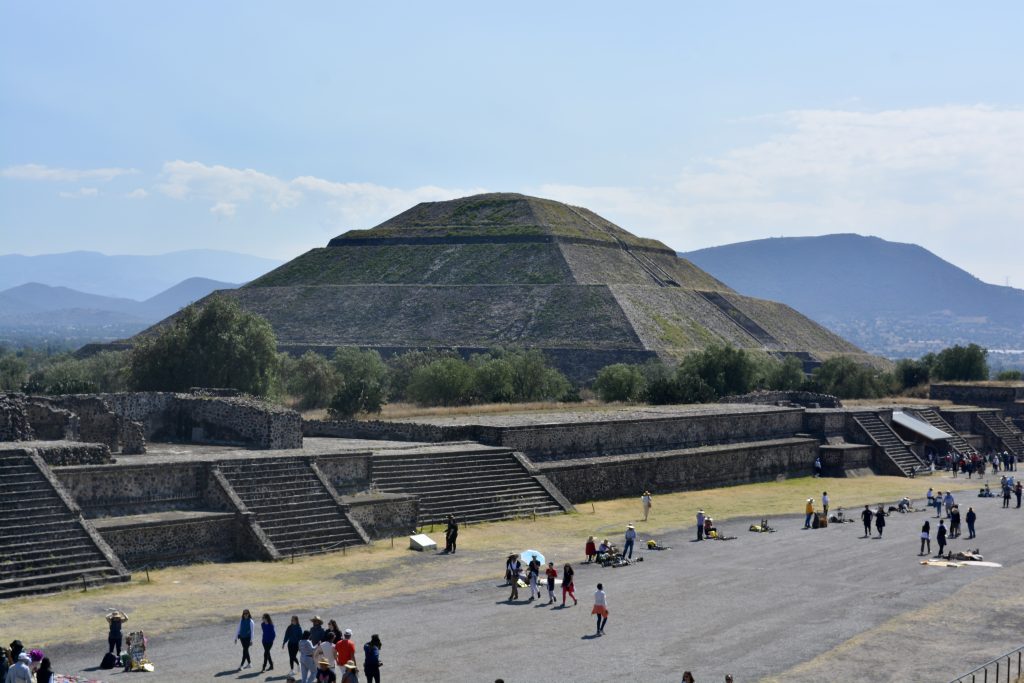
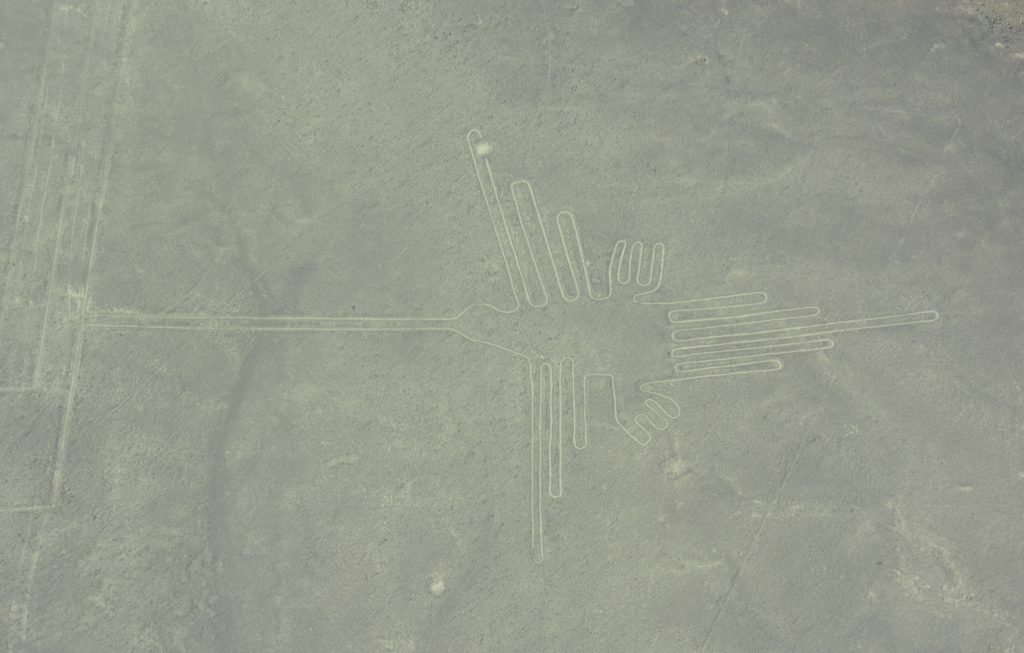
Chichen Itza (Mexico), located in the Yucatán Peninsula, is one of the largest and most visited Mayan sites. The famous El Castillo pyramid, with its precise astronomical alignments, draws tourists from around the globe.
Machu Picchu (Peru), the crown jewel of Incan civilisation, is the most famous site in Latin America. Perched high in the Andes, this UNESCO World Heritage Site is best visited via the challenging Inca Trail, a four-day trek reaching altitudes of 4,100 metres. Machu Picchu’s terraces, temples, and ceremonial sites are truly awe-inspiring and highlight the advanced engineering of the Incas.
Monte Albán (Mexico) is a stunning Zapotec city near Oaxaca, set on a mountain ridge. Its pyramids, terraces, and tombs offer impressive views and insights into Zapotec culture.
Nazca Lines (Peru), vast geoglyphs etched into the desert, are a mystery to archaeologists. They depict animals, plants, and geometric shapes that are best viewed from the air, making them one of Peru’s most famous attractions.
Palenque (Mexico) in the jungles of Chiapas is a striking Maya site, known for its finely detailed stone carvings and the grandeur of the Temple of the Inscriptions, the burial site of King Pakal.
Teotihuacan (Mexico), just outside Mexico City, was once one of the largest cities in the world. Its massive Pyramid of the Sun and Pyramid of the Moon dominate the skyline, making it a significant cultural and political centre in pre-Hispanic Mexico.
Tikal (Guatemala) is one of the most magnificent Maya cities, with towering pyramids that rise above the jungle canopy. The central Great Plaza is framed by the Temple of the Jaguar and Temple of the Masks, offering one of the most iconic views of Maya architecture.
Uxmal (Mexico), also a major Mayan site, is known for its Pyramid of the Magician and intricate stonework that showcases the artistic and architectural brilliance of the Mayan civilisation.
7.2 Lesser-Known Archaeological Sites
For travellers seeking a more off-the-beaten-path experience, Latin America also offers a wealth of lesser-known, yet equally impressive, archaeological treasures. These sites provide quieter, more intimate explorations of ancient civilisations.
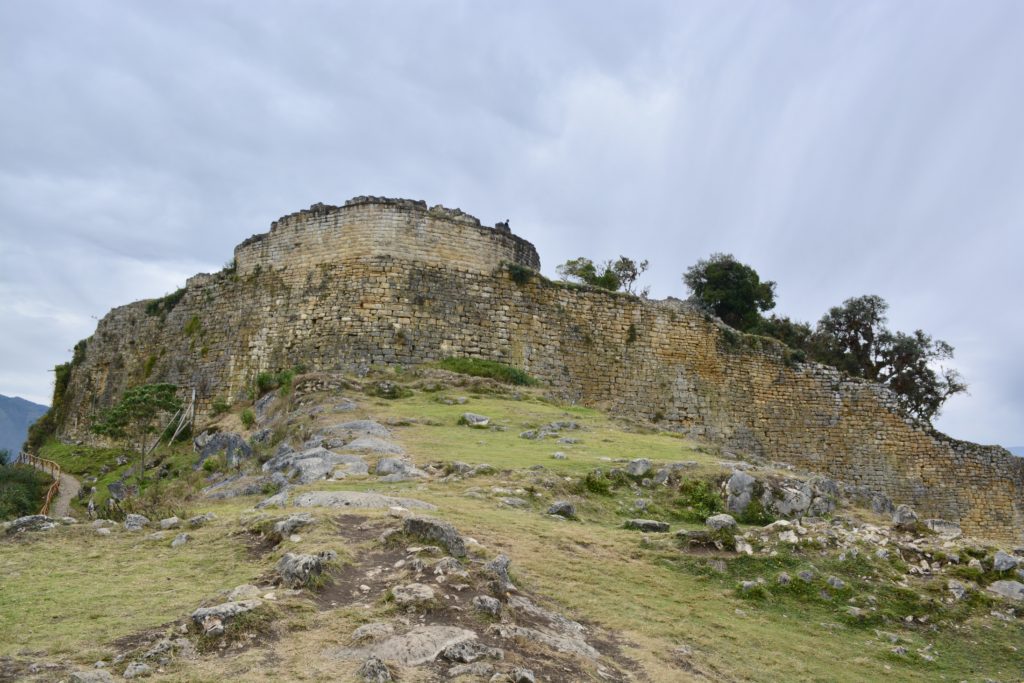

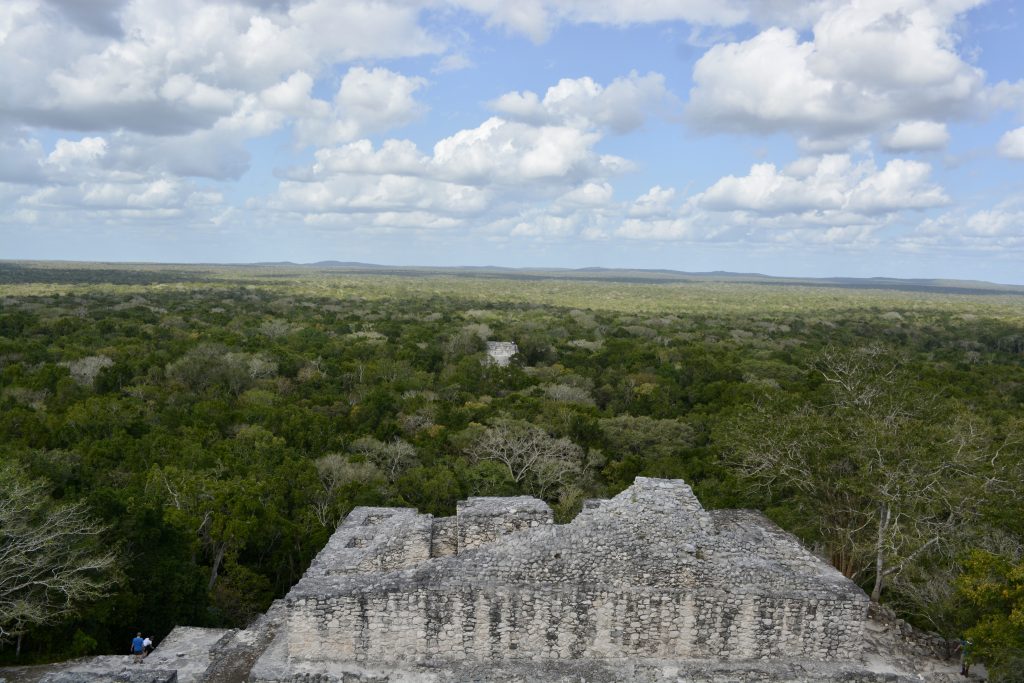
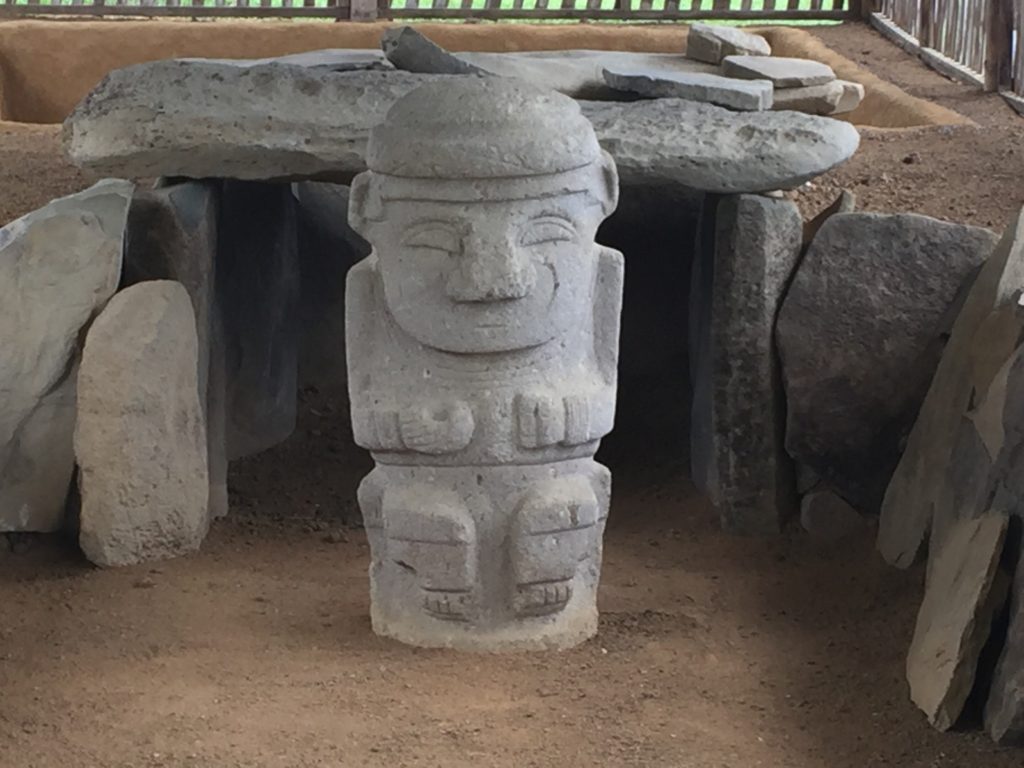
Calakmul (Mexico), located deep in the jungle near the Guatemalan border, is one of the largest Mayan cities, yet it remains largely undiscovered by mass tourism. Its towering pyramids, surrounded by dense forest, offer a truly immersive experience.
Chan Chan (Peru), the largest adobe city in the world, was the capital of the Chimú civilisation. Located near Trujillo, it is an enormous complex of ceremonial plazas and intricate adobe walls that once housed a bustling coastal society.
Chavín de Huantar (Peru), situated in the Andes near Huaraz, is a pre-Incan temple complex known for its underground passageways and stone carvings, reflecting the religious and political power of the Chavín culture.
Copán (Honduras), although often overshadowed by more famous Mayan sites, is renowned for its detailed stone sculptures and the iconic Hieroglyphic Stairway. Its art and architecture provide a fascinating insight into Mayan culture and its hieroglyphic texts.
Isla del Sol and Isla de la Luna (Bolivia), located on Lake Titicaca, are said to be the birthplace of the sun and moon in Incan mythology. These islands house sacred ruins, including temples dedicated to these celestial bodies, and offer a peaceful atmosphere for exploration.
Kuelap (Peru) is often compared to Machu Picchu, but far fewer tourists make the journey to this ancient fortress built by the Chachapoyas civilisation in northern Peru. The site’s massive stone walls and circular structures are perched on a remote mountaintop, offering breathtaking views of the surrounding cloud forest.
San Agustín (Colombia) is one of the largest collections of pre-Colombian megalithic sculptures. Its mysterious statues, depicting both human and animal figures, stand guard over tombs and ceremonial sites, providing a unique insight into an ancient civilisation.
Tierradentro (Colombia) is another hidden gem, featuring a series of underground tombs carved into the mountains, adorned with intricate paintings and carvings. These tombs offer a glimpse into the burial rituals of ancient Andean cultures.
Tiwanaku (Bolivia), near Lake Titicaca, showcases the architectural and engineering skills of one of the most advanced pre-Inca civilisations. Its massive stones, intricately carved structures, and Gateway of the Sun are highlights of this site.
These lesser-known sites offer a more secluded experience, often far from the tourist crowds that flock to the more famous landmarks, providing rich archaeological insights and opportunities for discovery in the heart of Latin America.
8. Hidden Treasures & Off-the-Beaten-Path
Latin America offers a variety of hidden gems that extend beyond its well-known archaeological wonders and colonial towns. From pristine beaches and remote savannahs to vast national parks, these destinations are perfect for travellers seeking off-the-beaten-path experiences.
8.1 Beaches
Canoa Quebrada (Brazil): Located along Brazil’s “Route of the Sun” in Ceará, Canoa Quebrada features dramatic red sandstone cliffs overlooking the Atlantic. Known for its bohemian vibe, this beach town attracts both adventurers and those looking to relax in its peaceful setting. Horseback riding through the surf, paragliding, and dune buggy rides are popular activities. The area has an emerging eco-tourism scene, adding to its off-the-beaten-track appeal.
Florianopolis (Brazil): Florianopolis, often called “Floripa,” is situated on an island in southern Brazil. Famous for its pristine beaches, it offers a mix of quiet, secluded coves and lively resorts. Highlights include Praia Mole, popular with surfers, and Joaquina Beach, known for its sand dunes and windsurfing.
Huanchaco (Peru): Huanchaco is a charming coastal town known for its connection to ancient Moche and Chimu cultures, especially its use of totora reed boats. Beyond its historical significance, the town is a major surfing destination with consistent waves and an easy-going atmosphere. The town’s connection to local traditions and its proximity to Chan Chan make it a hidden gem on the Peruvian coast.
Itacaré (Brazil): Located in Bahia, Itacaré is known for its secluded beaches framed by rainforest and cacao plantations. Surfers love Itacaré for its reliable waves, while others are drawn to its eco-tourism scene. The town has a relaxed vibe, offering easy access to both lush forest hikes and tranquil beaches like Praia da Concha and Havaizinho.
Jericoacoara (Brazil): Nestled in the northeastern state of Ceará, Jericoacoara (commonly known as “Jeri”) is famous for its laid-back atmosphere, sand dunes, and clear lagoons. What was once a quiet fishing village has become a popular spot for kite surfing, windsurfing, and enjoying sunsets from the Duna do Pôr do Sol (Sunset Dune). Despite its rising popularity, it maintains a rustic charm with its unpaved streets and remote location accessible by 4×4 vehicles. Jeri’s beachside caipirinha stands and boutique beachwear shops add to the experience.
Praia da Pipa (Brazil): Further south in Rio Grande do Norte, Praia da Pipa is a haven for surfers, beach lovers, and nature enthusiasts. This beach is surrounded by cliffs and Atlantic Forest, offering a perfect mix of stunning natural beauty and vibrant nightlife. Dolphins are often seen playing near the coast, and the nearby Chapadão cliff provides panoramic views of the beaches below.
Tayrona National Park (Colombia): The beaches within Tayrona National Park are among Colombia’s most picturesque and pristine coastal destinations. The park is renowned for its stunning natural beauty, featuring a mix of golden sandy beaches, lush tropical forests, and rugged mountains. Cabo San Juan, one of the park’s most famous beaches, offers a stunning setting with its inviting turquoise waters and beautiful rock formations. Visitors can hike through the park’s scenic trails, leading to secluded beaches like La Piscina, where calm waters provide an ideal spot for swimming and relaxation.
8.2 National Parks and Natural Reserves
Amazon Delta (Delta do Amazonas) – Brazil Stretching across Brazil, the Amazon Delta represents one of the most biodiverse regions on Earth. While its primary allure lies in its vast natural beauty rather than historical artefacts, it remains an important site for those seeking to understand ancient cultures. The delta was once home to pre-Columbian civilisations, whose legacies have been preserved in ancient mounds called terra preta. These patches of fertile black soil indicate advanced agricultural practices, evidence that the Amazon was home to large and complex societies before European contact.
The Amazon Delta, particularly near Macapá and Belém, is a striking destination to explore by boat, where you experience the enormity of the river as it widens to over 300 km at its mouth. The surrounding forest is rich with wildlife, and the delta is key to understanding how the Amazon River supported both ancient and modern communities.
Bigi Pan (Suriname): Bigi Pan is a nature reserve known for its wetlands and salt pans, which attract a diverse range of bird species, including the vibrant scarlet ibis and flamingos. Visitors can explore the area by boat, making it an excellent off-the-beaten-path destination for birdwatchers and nature enthusiasts.
Cave of Hands (Cueva de las Manos) – Argentina Hidden in the remote Patagonia region, this UNESCO World Heritage site is known for its prehistoric rock art dating back 9,000 to 13,000 years. The cave features handprints (stencilled in vivid reds, yellows, and black), along with animal depictions and hunting scenes. The paintings, created by ancient hunter-gatherer communities, are particularly famous for the hand stencils made using a spraying technique. The site provides a fascinating glimpse into the lives of early human societies in South America.
Chapada Diamantina (Brazil): Located in Bahia, Chapada Diamantina is known for its plateaus, caves, and waterfalls. The region is a paradise for hikers, with trails leading to spectacular viewpoints such as Morro do Pai Inácio and stunning falls like Cachoeira da Fumaça, one of Brazil’s highest waterfalls. The park also has historical significance due to its diamond mining past.
Chapada dos Veadeiros (Brazil): A UNESCO World Heritage Site, Chapada dos Veadeiros in Goiás is known for its dramatic canyons, waterfalls, and diverse wildlife. Visitors can explore trails that lead to some of the park’s most stunning features, including the Cachoeira Almécegas and Cataratas dos Couros. The park is also known for its mystical energy, attracting those seeking spiritual experiences.
Iwokrama Forest and Rupununi Savannah (Guyana): Iwokrama Forest is one of the last pristine tropical forests in the world, rich in wildlife including jaguars and giant river otters. The Rupununi Savannah offers a contrast, with its vast grasslands and wetlands supporting an array of wildlife such as giant anteaters and capybaras. Both regions are still largely untouched by mass tourism.
Lençóis Maranhenses National Park (Brazil): One of the most unique landscapes in the world, Lençóis Maranhenses is located in Maranhão. This park features vast white sand dunes interspersed with clear blue lagoons that form during the rainy season. A flight over the dunes or a walk through the surreal landscape, particularly around Atins, offers an unforgettable experience. The area’s remoteness adds to its charm, providing an off-the-beaten-path adventure.
Leticia (Colombia): Leticia, located in the Amazon region of Colombia, is a gateway to the vast Amazon Rainforest. Visitors can take boat trips along the Amazon River, exploring remote indigenous villages, spotting pink river dolphins, and experiencing the unparalleled biodiversity of the Amazon basin.
Quilotoa Loop (Ecuador): The Quilotoa Loop is a hiking circuit in the Ecuadorian Andes that leads to the stunning Quilotoa Crater Lake, a turquoise lake in the caldera of an extinct volcano. The trek passes through remote villages, offering opportunities to experience traditional Andean culture.
Reserva de Fauna Andina Eduardo Avaroa (Bolivia): This reserve, located in the remote southwest of Bolivia, features some of the most surreal landscapes in Latin America. Highlights include the Laguna Colorada, a red lake home to thousands of flamingos, and the Sol de Mañana geysers. Its high-altitude desert landscapes offer an otherworldly experience far from the crowds.
Tatacoa Desert (Desierto de la Tatacoa) (Colombia): The Tatacoa Desert is a dramatic, semi-arid landscape known for its eroded rock formations and fossil beds. The red and grey canyons, stretching for miles, create an almost otherworldly feel. Fossils found here date back millions of years, making it an area of significant paleontological interest. The desert’s unique geography also makes it a prime location for stargazing, offering a breathtaking view of the night sky far from the light pollution of Colombia’s urban centres.
Valdés Peninsula (Argentina): A UNESCO World Heritage Site, the Valdés Peninsula is located in Patagonia and is one of the best places in South America for wildlife spotting. Visitors can see southern right whales, orcas, sea lions, and Magellanic penguins in their natural habitats. The peninsula’s remote location makes it a peaceful and rewarding destination for nature lovers.
These destinations offer a range of landscapes and experiences, from isolated beaches to pristine national parks, catering to travellers looking for authentic and tranquil escapes far from the typical tourist circuits.
9. Travel Tips & Guides
9.1 Language
The languages spoken across Latin America reflect the region’s colonial history, with Spanish and Portuguese being the two dominant languages. Spanish is the official language in the majority of countries, while Portuguese is spoken in Brazil. However, the versions of these languages spoken in Latin America differ significantly from those used in Spain and Portugal.
Spanish and Portuguese in Latin America vs. Europe
The Spanish spoken in Latin America has evolved to include variations in vocabulary, pronunciation, and formality. One major difference is the use of more informal language in Latin American Spanish compared to European Spanish. For instance, in Spain, the formal “vosotros” is commonly used for addressing groups, whereas in Latin America, “ustedes” is used regardless of formality. Additionally, Latin American Spanish tends to be more straightforward, while European Spanish can include more complex verb forms and tenses, such as the use of the preterite imperfect.
Portuguese in Brazil is also distinct from the version spoken in Portugal. Brazilian Portuguese has a softer, more melodic intonation, with differences in both vocabulary and pronunciation. Formal Portuguese from Portugal often sounds more clipped and rapid to Brazilian speakers. For instance, the “tu” form (informal “you”) is more widely used in Portugal, while Brazilians more often use “você”, which is considered more neutral in tone.
Regional Variations of Spanish
Within Latin America, there are also substantial regional differences. Colombian Spanish, especially in Bogotá, is often considered one of the clearest and most neutral forms of Spanish, with a slower pace and precise pronunciation. Peruvian Spanish shares similar characteristics, with a neutral accent that makes it easier for non-native speakers to understand.
In contrast, Argentine Spanish, or Rioplatense Spanish, is heavily influenced by Italian due to large waves of Italian immigration. This gives the language a distinct rhythm and introduces various Italian words into everyday speech. For example, “ciao” is commonly used instead of the Spanish “adiós.” Additionally, Argentina and Uruguay use the voseo form, replacing “tú” with “vos,” adding another layer of complexity for learners.
Chilean Spanish can be challenging for learners due to its rapid pace and the frequent use of slang. Chileans often drop consonants at the end of words, which makes it sound less distinct than other regional accents. Moreover, slang or “modismos” is common in everyday speech, so much so that even native Spanish speakers from other countries can find it hard to understand.
Language Preparation and Travel Enhancement
It is highly recommended to learn some basic Spanish before travelling to Latin America. Familiarising yourself with key phrases will enhance your experience, allowing you to connect more with locals and navigate easier, especially in regions where English is not widely spoken. Knowing how to ask for directions, order food, or greet people will enrich your interactions, even in tourist-heavy areas.
Many language apps, like Duolingo or Babbel, offer courses tailored to Latin American Spanish. Alternatively you could use a more structured learning programme such as Languages on a Plate which offers good value mobile friendly interactive courses, designed by a teacher who helps understand how the language works and provides useful content. Learning basic verb conjugations, greetings, and common travel-related vocabulary will make a noticeable difference in how you experience the region.
English Proficiency in Latin America
English proficiency varies across the continent. In tourist hubs and large cities such as Buenos Aires, Montevideo, or Mexico City, you will find many people, particularly younger generations and those working in tourism, who speak at least some English. In countries like Uruguay and Argentina, where there is a higher standard of education, English is more commonly spoken compared to more rural areas or countries like Bolivia or Paraguay, where English speakers are rarer.
In Brazil, despite its economic stature, English is not widely spoken outside major cities like Rio de Janeiro and São Paulo, especially in more rural areas. This is partly due to the language barrier created by Portuguese. However, in countries like Uruguay and Argentina, especially in cosmopolitan areas, you are likely to find English speakers more frequently.
If you are travelling off the beaten path, to places like the Amazon Delta or remote Andean villages, it is advisable to know some Spanish (or Portuguese in Brazil) as English speakers will be hard to come by. Even in tourist destinations, being able to speak the local language will improve your cultural immersion and help you connect more deeply with the people and the place. For example, when you have an English-speaking guide in some tourist sites you may find that their English is rudimentary and that their explanations in Spanish is much fuller and informative. Even with a basic level of Spanish, and with technical words often being similar, it is often far better to listen to the Spanish version. Also in places like the highlands of Guatemala, Bolivia and Peru, Spanish may actually be the guide’s second language.
9.2 Altitude
When travelling in South America, particularly in countries like Colombia, Bolivia, and Peru, altitude can significantly impact your experience. Cities such as Bogotá (approximately 2,600 metres) and Mexico City (about 2,100 metres) serve as ideal waypoints for acclimatisation. Spending a minimum of two to three days in these high-altitude cities allows your body to adjust gradually to reduced oxygen levels, minimising the risks associated with altitude sickness. In contrast, cities like Quito (about 2,850 metres) and La Paz (the world’s highest capital at approximately 3,650 metres) require more careful preparation due to their higher altitudes. These locations can pose greater challenges, necessitating a longer acclimatisation period before embarking on high-altitude treks.
As altitude increases, particularly for treks over 4,000 metres, the demands on your body escalate. For example, Machu Picchu sits at around 2,430 metres, while Cusco is about 3,400 metres, both requiring acclimatisation for optimal enjoyment of the region’s breathtaking landscapes. Some treks, such as Laguna 69 (at approximately 4,600 metres) and classic sections of the Inca Trail (which reaches heights of 4,215 metres at Dead Woman’s Pass), present significant altitude challenges. Notably, certain areas in Bolivia,including the Sol de Mañana Geyser and Peru, including parts of the Colca Canyon (rise above 5,000 metres), and exceed the height of Mont Blanc, the tallest mountain in Europe, which stands at 4,810 metres. It’s crucial to build up acclimatisation by gradually increasing your altitude exposure, as we did while traversing between Salta (about 1,200 metres), San Pedro de Atacama (around 2,400 metres), and Potosí (approximately 4,090 metres) before reaching La Paz (at 3,650 metres).
When crossing borders, be mindful of elevation changes as well. The border crossing from Argentina into San Pedro de Atacama is at about 3,300 metres, while the route from San Pedro to Southern Bolivia can reach elevations of approximately 4,000 metres.
Tips for Altitude Preparation
Preparing for altitude not only involves acclimatisation but also the right gear and self-care strategies. Wearing a wide-brimmed hat is essential to protect against the intense sun at higher elevations, and staying hydrated is paramount; aim for three to four litres of water daily. When trekking, plan for regular rest points to allow your body to adapt. Monitoring your heart and pulse rate is important, as they will increase at higher altitudes, often taking three days or more to return to normal after you descend. Traditional remedies, especially in Bolivia and Peru, can help alleviate altitude sickness. For instance, coca tea is widely consumed to combat symptoms, and quinua (quinoa), a local grain, is known for its nutritional benefits that can aid acclimatisation.
By understanding altitude and taking the necessary precautions, you can enjoy the stunning landscapes and cultural richness of South America while minimising the discomfort associated with high elevations.
9.3 Money in Latin America
Latin America is increasingly embracing modern financial technology, with most countries widely supporting Apple Pay, contactless card payments, and digital banking. This has become especially prevalent in urban areas across countries like Brazil and Colombia, where digital transactions are preferred due to their security advantages, reducing the risk of robbery when compared to carrying cash.
However, Argentina stands as an exception. The country has experienced an extended period of financial instability, resulting in less reliance on card payments. Due to inflation and economic crises, USD cash is frequently used, and it’s common to shop around for the best exchange rate. Many semi-official channels exist for exchanging foreign currency at more favourable rates than what is offered by banks.
Even in countries that have traditionally been governed by the left, such as Nicaragua and Bolivia, digital payments have become more widespread, reflecting a modern financial infrastructure. That said, cash remains king in rural and remote areas across the continent, where access to reliable digital services may be limited.
ATM Withdrawals & Currency Conversion
When withdrawing cash or making card payments, it’s essential to avoid paying in your home currency. ATMs and payment systems often offer the option to pay in your currency, but this comes with a wide bid-offer spread (difference between buy and sale rates). Opting to pay in the local currency ensures that the FX conversion is handled by your home bank, usually offering a more competitive exchange rate closer to the interbank rate.
Be aware that withdrawing cash at ATMs often involves fees. Local banks in Latin America typically charge for ATM withdrawals, and your home bank might impose additional fees. You can minimise these costs by using credit or debit cards for payments, especially if you find a card with low or no foreign transaction fees.
USD Usage
In some countries like Ecuador and Panama, which use the USD as their official currency, prices tend to be higher, reflecting the relative stability and international value of the dollar. In contrast, countries with their own currencies often offer more competitive prices for tourists.
When taking cash to Latin America it is always best to come with USD, indeed while you can exchange currencies like GBP, AUD and EUR at international airports, there is little local demand for these currencies so exchange rates will not be very competitive. In the cities EUR may be accepted, especially in Brazil and Argentina, but less so elsewhere.
Tips for Managing Money
Credit & Debit Cards: Shop around for credit or debit cards that offer low foreign transaction fees. The differences can be significant, and some cards waive these fees entirely.
- Cash in Remote Areas: Always carry USD cash when travelling to more remote regions, as many rural areas in Latin America still operate on a cash-only basis.
- Argentina: If travelling in Argentina, keep USD cash on hand, as the exchange rate can vary widely depending on where you exchange your money, with unofficial channels often offering better rates.
This mixed approach to money management is vital to navigating Latin America’s diverse financial landscape effectively.
Transport
What to bring
10. Map
The map below traces our year long journey around South America
11. Recent Posts
12. About Us & Contact
Click here to read blog posts.
13. Journey Days
| Country | Days |
| Argentina | 46 |
| Bolivia | 17 |
| Brazil | 82 |
| Chile | 20 |
| Colombia | 47 |
| Ecuador | 27 |
| French Guiana | 5 |
| Guyana | 7 |
| Peru | 46 |
| Suriname | 7 |
| UK | 20 |
| Uruguay | 9 |
| Total | 333 |



